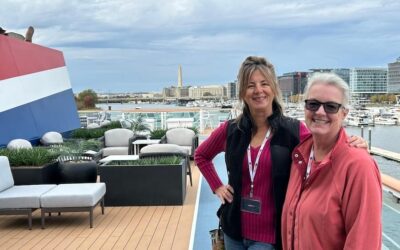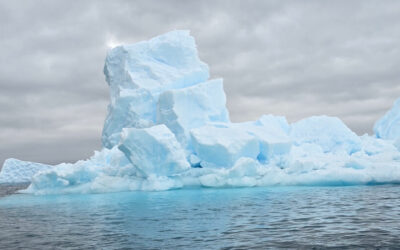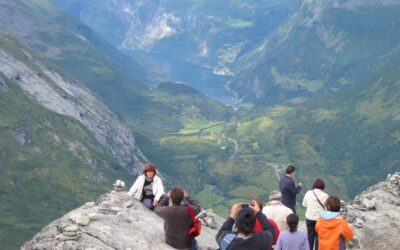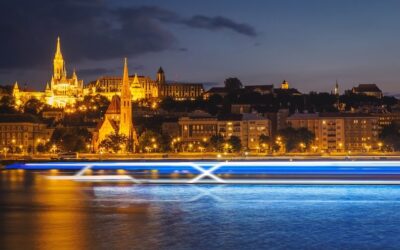Brahmaputra River Cruising on Sukapha
By Hema Maira
Serendipity was at play when I called a friend in October last year to explore travel plans for December. She mentioned a cruise she was contemplating.
“Wow!” I said. “Tell me more!”
And, thereby as they say, hangs a tale.
A river cruise, called “Gently Down the Brahmaputra,” aboard the 24-pax Sukapha, was being offered by Ibex Expeditions, a well-respected India-based adventure travel company who bundles a handful of interesting small-ship cruises like this one with other components like a land-based tour and hotel package before or after the cruise.
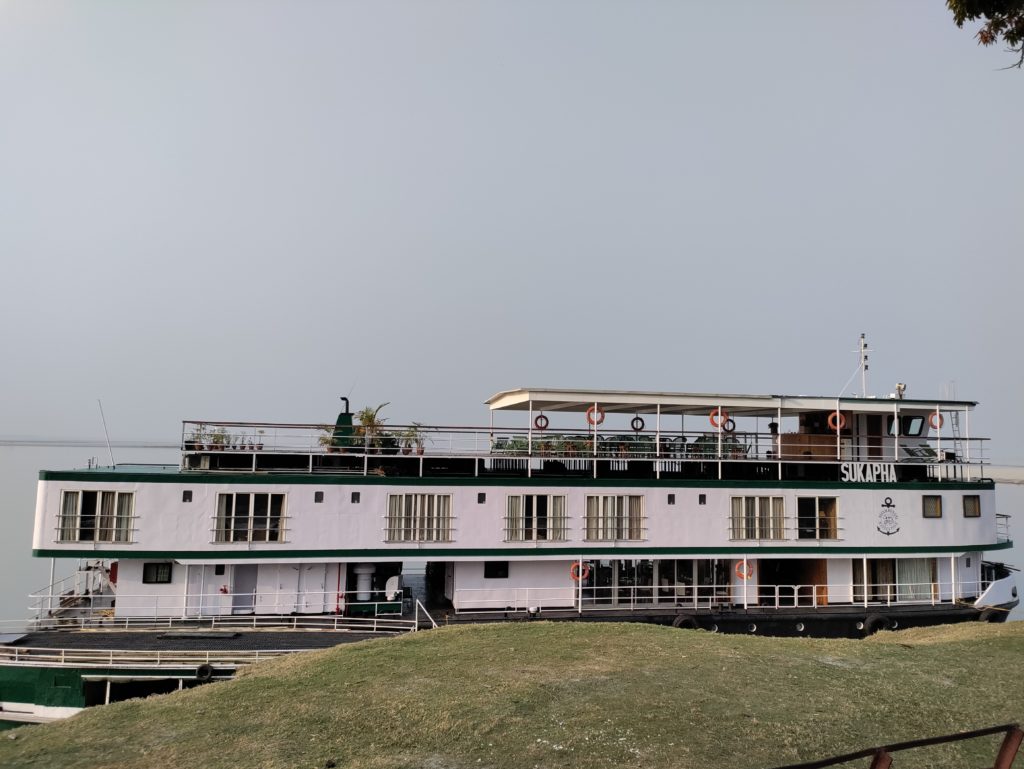
The 24-pax Sukapha from shore. * Photo: Hema Maira
Mandip Singh Soin, well-known explorer, mountaineer and adventure traveler, followed his heart and passion when he started his company Ibex Expeditions in 1979.
Mandy, as he is known, and his wife and partner Anita, have operated Ibex for more than 40 years and are, arguably, the gold standard in adventure travel.

Mandy & Anita of Ibex Expeditions. * Photo: Hema Maira
I have known Mandy and Anita for decades. Mandy and my brother Arjun attended the same college in the late 70s, were rock-climbing and mountain-climbing mates, and have been dear friends since.
For years I had heard glowing reports from mutual friends about Ibex trips, but I somehow had not actually experienced one of their journeys myself. This was soon to be remedied.
With Mandy and Anita leading the trip, I knew this Brahmaputra River cruising adventure would be a memorable one!
Travel is in my Blood
For as far back as I can remember, my father’s oft-repeated maxim was, “Travel is the greatest form of education.”
As I got older, I found myself taking that adage ever more seriously.
I have travelled fairly extensively and consider myself a rather intrepid traveller.
Other than fairly standard touristy trips to many cities, mountains, deserts and wildlife reserves around India, Europe and the US over the past 40 years or so, I’ve had my share of more exciting trips.
These adventures have included chasing Tasmanian devils, quolls and pademelons in Tasmania; exploring Madagascar and its exotic bird life; being awestruck by the annual wildebeest and zebra migration in Kenya; walking around Komodo Island, Indonesia, watching basking “dragons;” and a four-week trip across Russia, Mongolia and Beijing aboard the Trans-Mongolian railway.
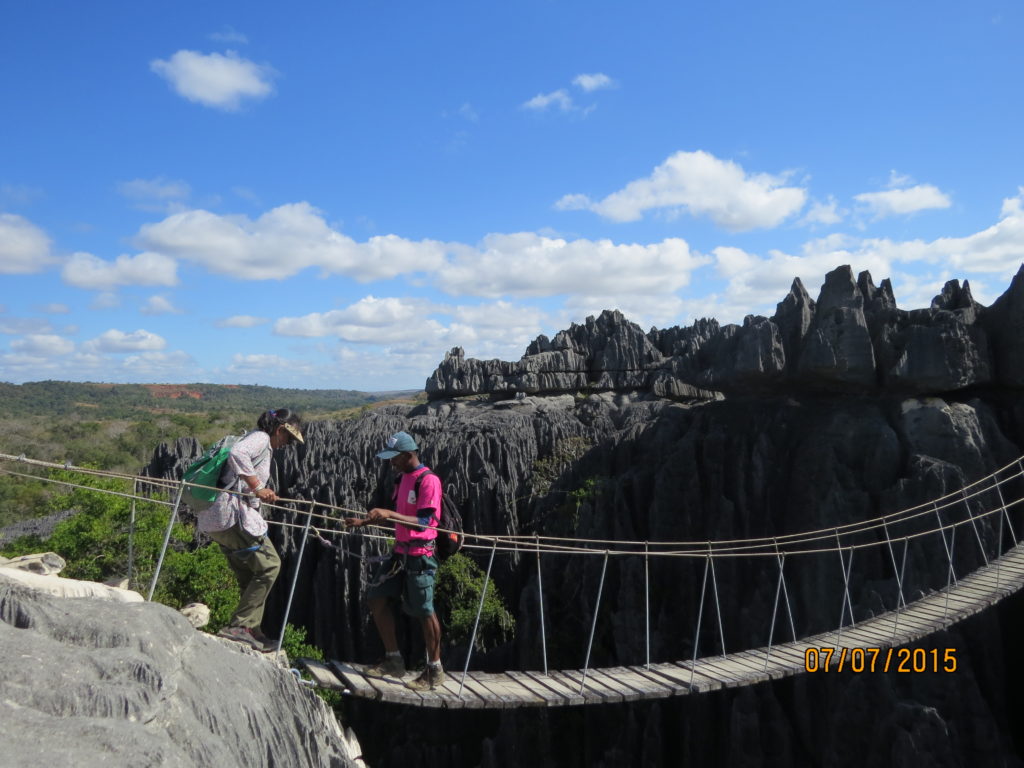
Hema on a rope bridge in the Tsingy de Bemaraha National Park in northwest Madagascar. * Photo: Hema Maira
More recently, I embarked on a solo trip (along with my guide and driver of a rented car) to three states in northeast India — Assam, Nagaland and Arunachal.
The focus of this trip was to see the annual, month-long migration of the Amur falcons. Arriving from Siberia to coincide with breeding termites, these small raptors spend about a month in the Pangti Valley in Nagaland fattening up on much-needed protein.
Fortified thus, they fly non-stop for three to four days to their wintering grounds in South Africa. (Naga, a male Amur falcon, weighing just 179 grams and tracked by satellite telemetry, flew from Nagaland to Somalia in eastern Africa in November, crossing India and the Arabian Sea, for five days and 10 hours non-stop, covering a distance of 5,600 kms.)
I digress, but with birding being the focus, it turned out to be an awesome trip!
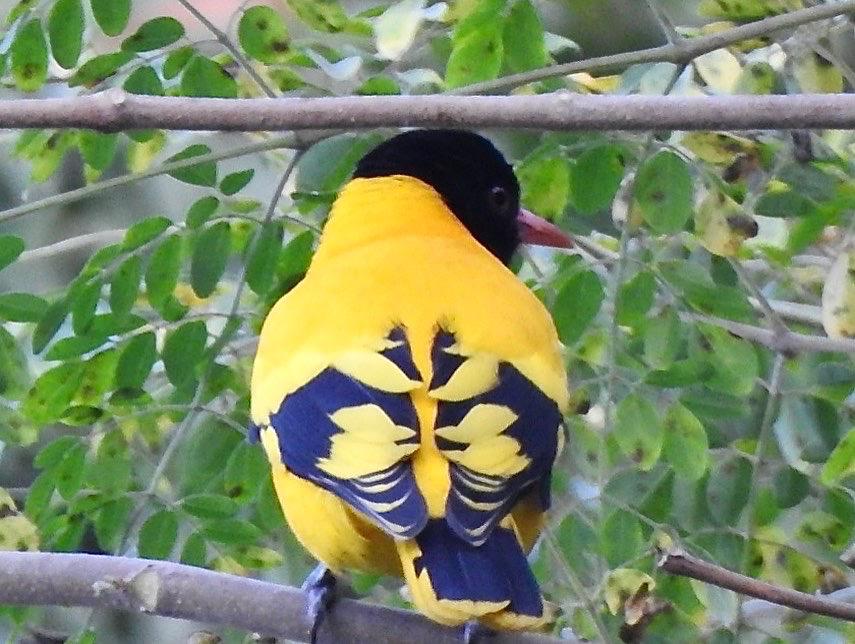
A black-hooded oriole spotted on a shore excursion. * Photo: Gautam Mehra
As you may have guessed by now, my interest and passion are in, and for, wildlife and the natural world.
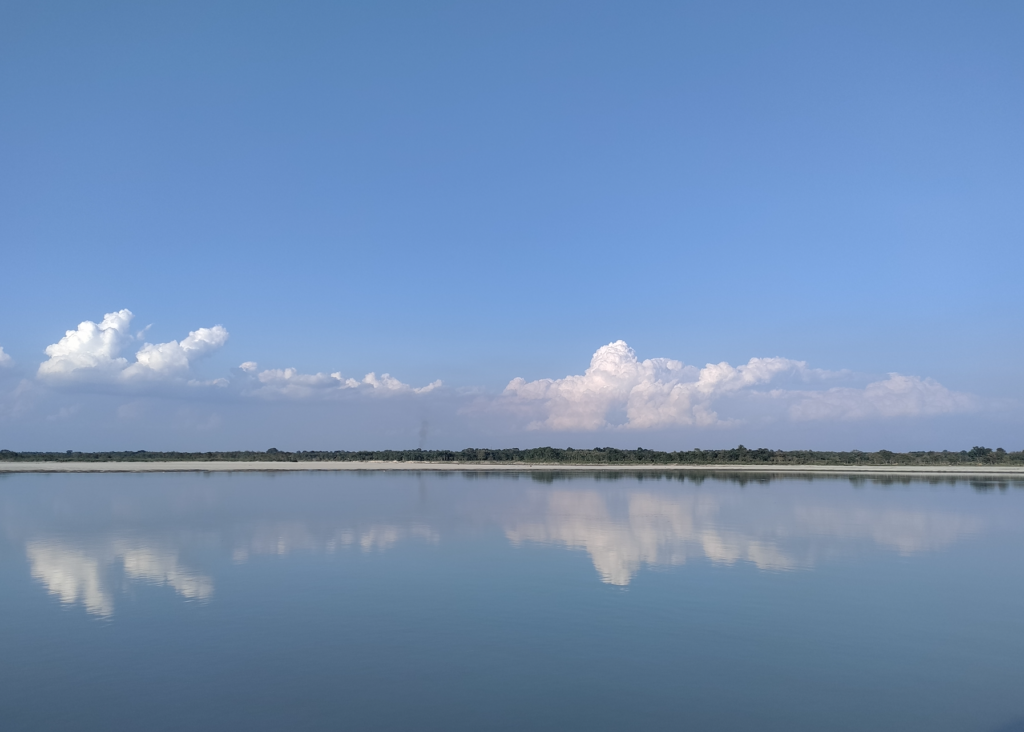
Glorious day on the Brahmaputra River. * Photo: Hema Maira
And so, the thought of cruising down the mighty Brahmaputra River for five days with an additional two nights at Kaziranga National Park, a UNESCO World Heritage Site, spoke to my soul.
Brahmaputra River Cruising — Arrival in Guwahati
We landed at Guwahati International Airport at noon and were transported in two comfortable 20-passenger mini buses for the half-hour drive to Pandu Port to board the Sukapha — one of five river boats owned by Assam Bengal Navigation (ABN).
Our group was a mixed bag. In all, 22 folks of Indian origin from different places and various backgrounds found common ground as adventure-seekers and fellow travelers.
While most of us lived in Delhi, others flew in from Hyderabad, Bangalore, Dubai and the US. Ibex Expeditions’ trips in general are also popular with travelers from the UK and North America as well.
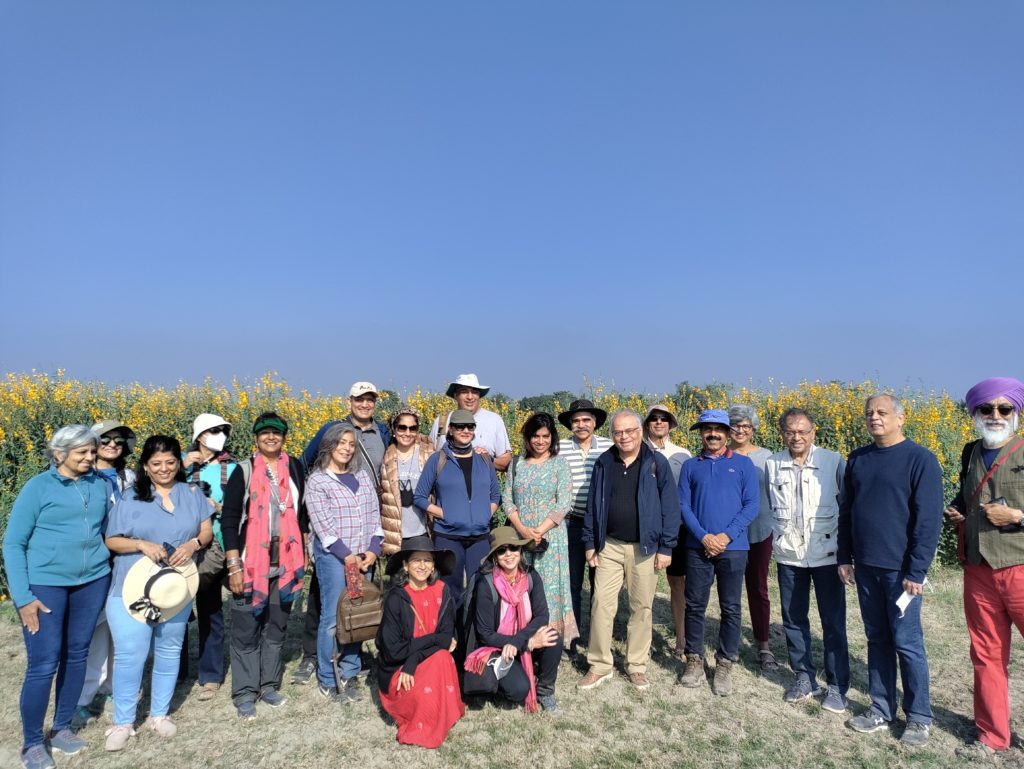
The group in Khirakata. * Photo: Hema Maira
The Brahmaputra — Mighty, Magical, Mystical River
India’s only “male,”river, Brahmaputra means son of Brahma.
It is the ninth largest river in the world by discharge and the fifteenth longest at 2,880 kilometers.
From its beginnings in the Tibetan Plateau, the Brahmaputra River flows through three countries.
It is known by different names — the Tsangpo in Tibet; Siang/Dihang in Arunachal Pradesh (where it enters India); Brahmaputra in Assam; and with an inexplicable change of gender, the Jamuna in Bangladesh.
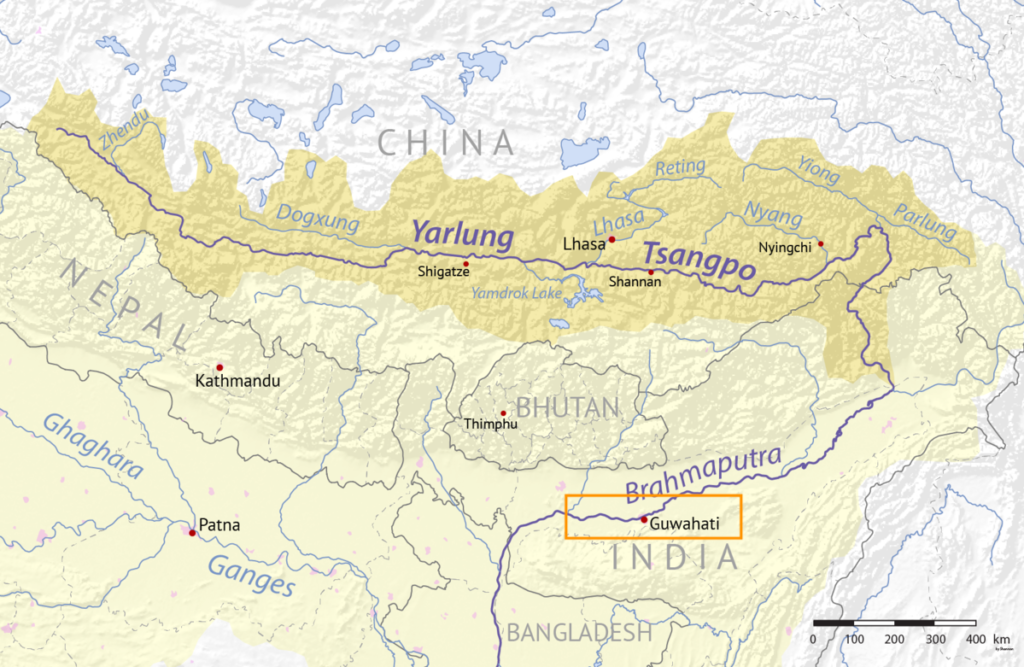
Map of Brahmaputra River with its various names, and showing the section of the Brahmaputra traversed during the cruise. * Image: https://commons.wikimedia.org/wiki/File:Yarlung_Tsangpo_map.png
The river floods annually during the monsoon from June to October leading to an agonizing dichotomy. While there is heart-breaking devastation all around due to the flooding, the flood waters also deposit large quantities of fertile silt far up the valley thus replenishing the soil.
Myth and legend abound along the course of the river.
Revered, feared and worshipped all at the same time, the Brahmaputra is dramatically destructive and undoubtedly life-giving in equal measure.
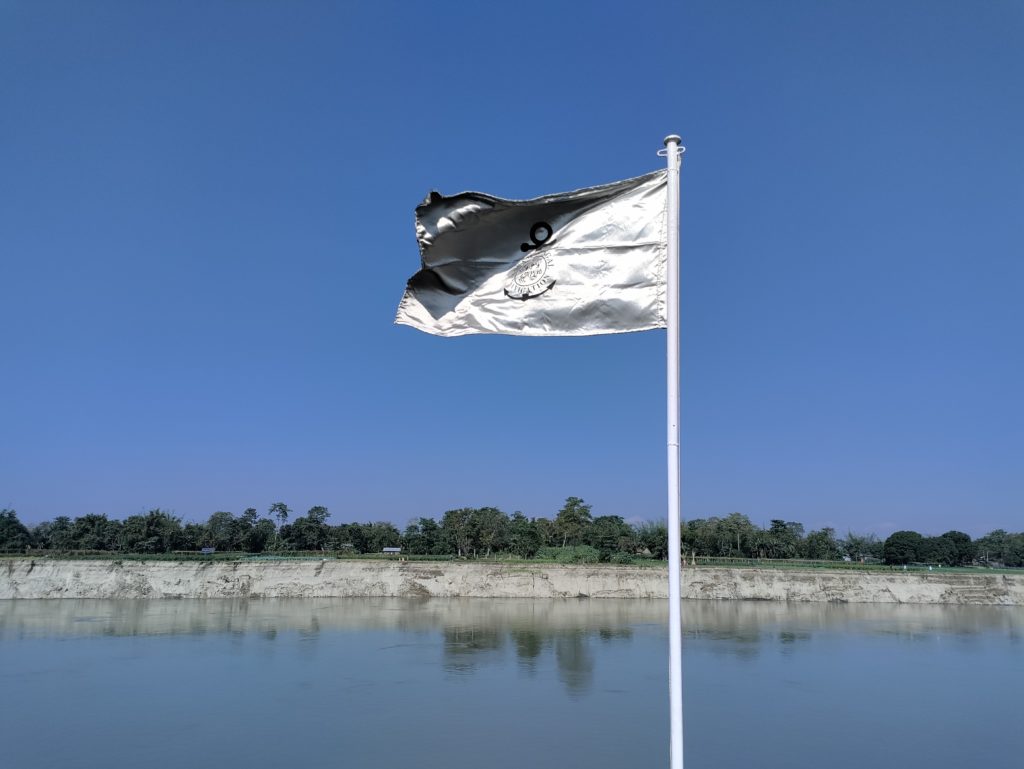
Sukapha’s ABN flag against the backdrop of the Brahmaputra River and the sandy shore. * Photo: Hema Maira
Overview of the Riverboat Sukapha
The Sukapha river boat is named after Chaolung Sukapha, a 13th-century ruler who founded the Ahom kingdom that ruled Assam for six centuries.
The upper deck has 10 twin-bedded cabins and two double-bedded cabins, for a total of 24 berths. Air-conditioned with bamboo wall paneling and en-suite bathrooms, each cabin has a large window overlooking the river. The two cabins at the stern are larger than the rest and have a view from two sides.
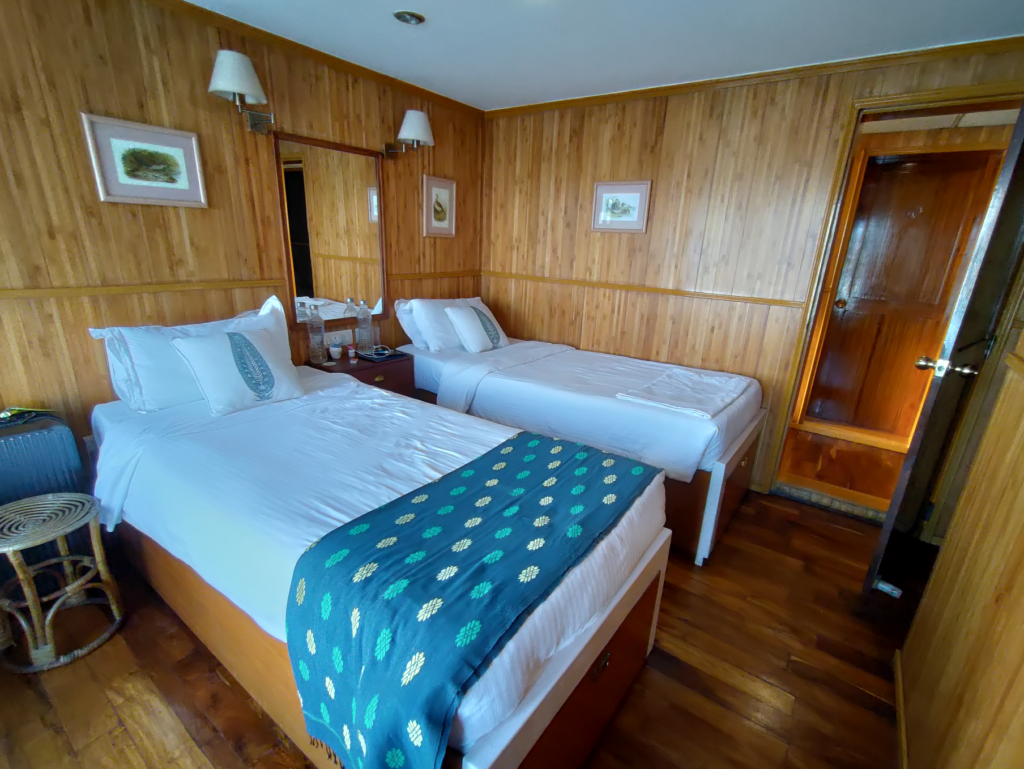
Hema’s twin cabin, #9. * Photo: Hema Maira
Morning tea and biscuits were served in a cheery comfortable saloon-cum-library on the same deck. Evening presentations took place here as well.

The Sukapha’s lounge. * Photo: Hema Maira
The dining room and a spa on the lower deck, and a spacious sun deck at the very top, made for a comfortable river boat.
Some members of our group availed of the spa facility onboard.
Prices ranged from Rs.1200 (about $16 USD) for a head and shoulders or back massage, and Rs.1800-2000 (about $24 to $27 USD) for a full body massage. Each massage was an hour long and booked by prior appointment. Though I didn’t try it, the spa was in demand and got positive reviews.
RELATED: Check out the Reader Reviews about this cruise from other passengers.
Brahmaputra River Cruising is all about the Journey
Eager anticipation and keen excitement ran high as our hosts Mandy and Anita welcomed us aboard Sukapha on the first day.
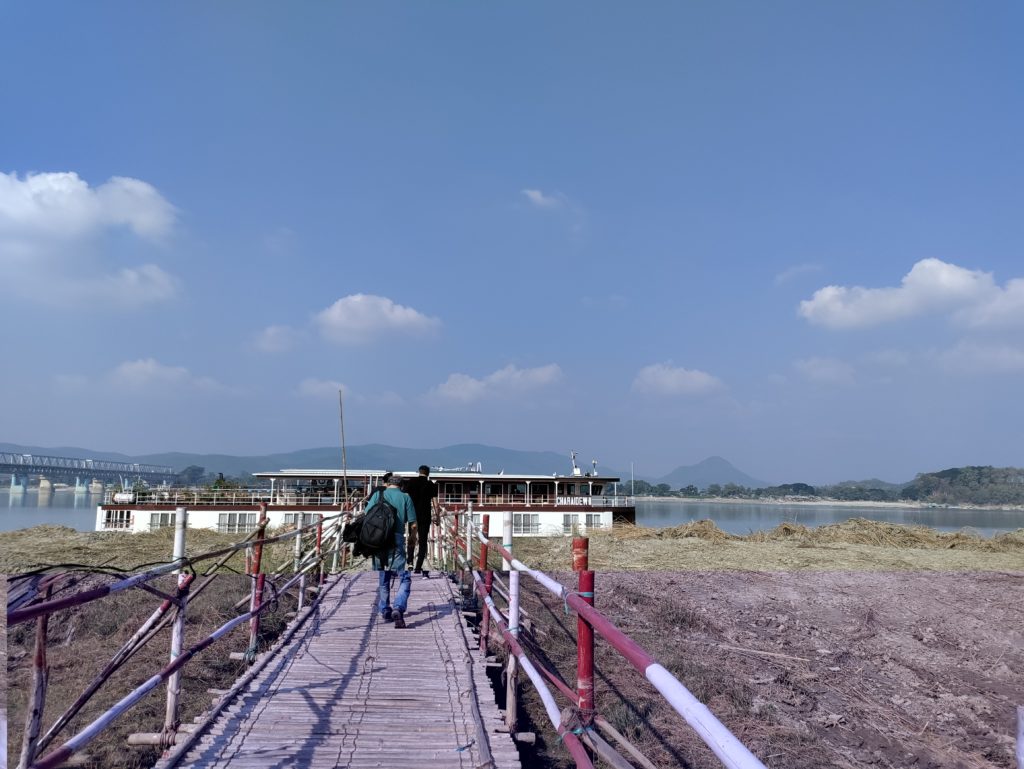
Walking down the gangway to board the Sukapha. * Photo: Hema Maira
We were to cruise upriver from Guwahati to Silghat, a distance of 240 kms by river.
The largest city in the region, Guwahati is situated between the banks of the Brahmaputra and the foothills of the Shillong plateau.
Wildlife sanctuaries, archaeological ruins and a silk-weaving centre are found around the city.
Cruising the river itself was unreservedly my favorite pastime.

An island mid-river. * Photo: Hema Maira
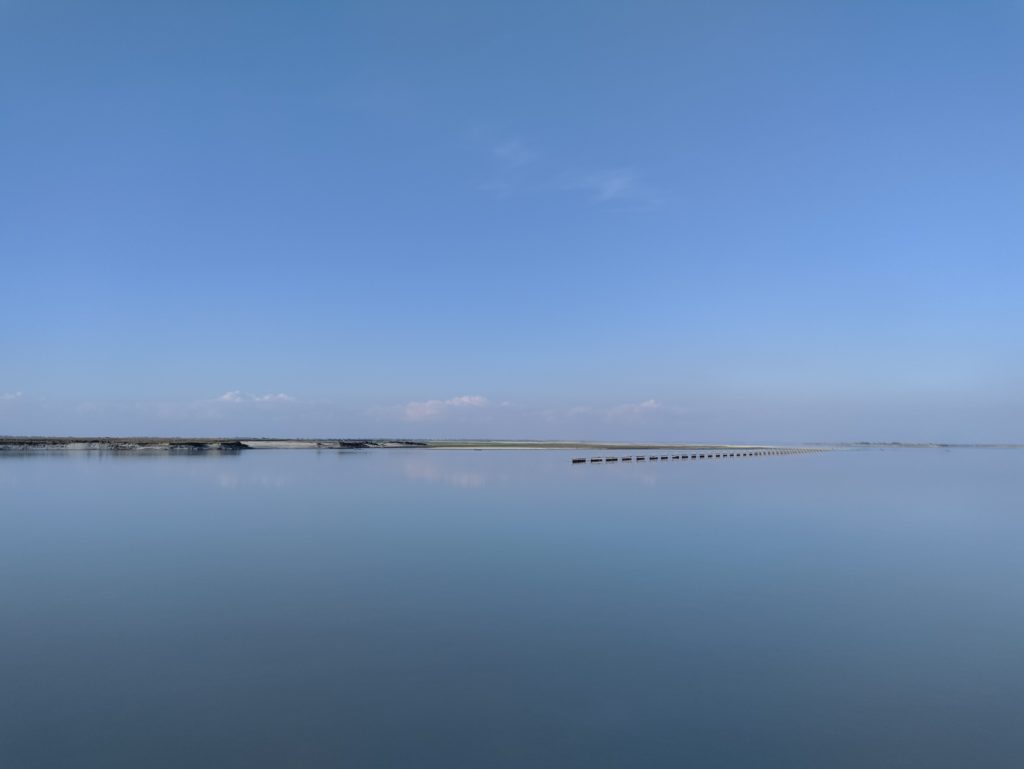
Bamboo construction helps to prevent changes to the shipping channel. * Photo: Hema Maira
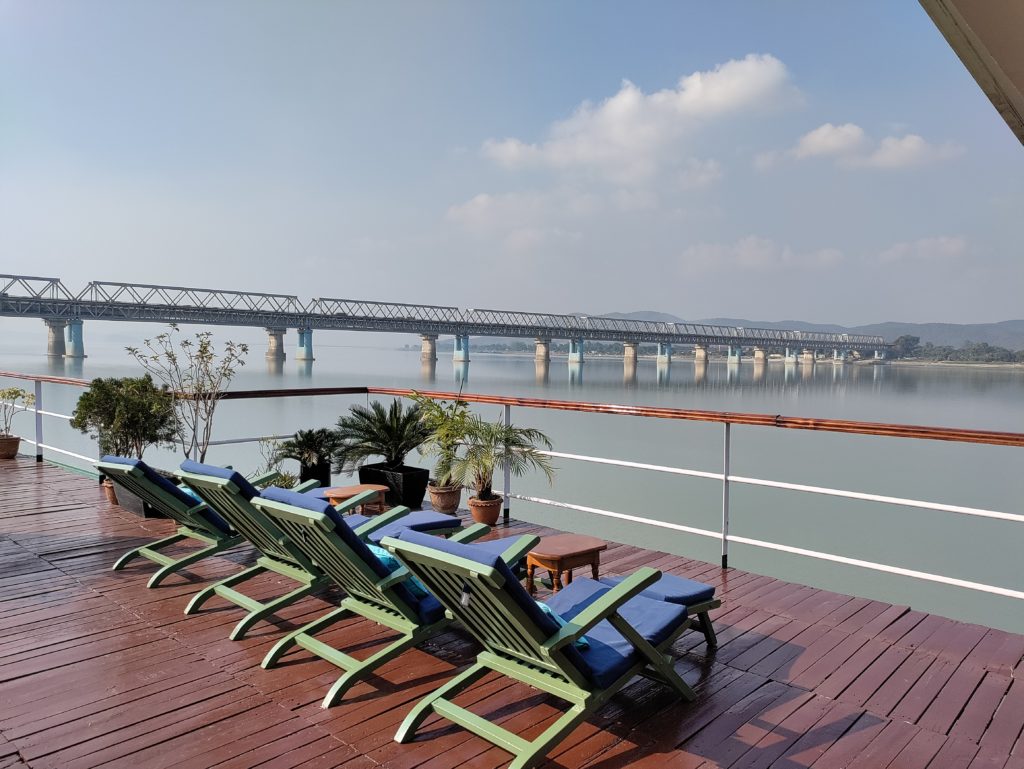
The view from the upper deck while cruising under the bridge at Pandu Port. * Photo: Hema Maira
The vessels and scenes we passed were varied and engaging. Each telling us something of the life, times and adaptations of living by the braided river.
There is a deceptively languid feel as the Brahmaputra flows, the smooth surface broken intermittently by little whirlpools bubbling up from its depths.
The calm and placid surface, however, belies the powerful and dangerous currents below. It is not known as a mighty, turbulent river for nothing.
Wildlife Along the Way
The salubrious environs were invigorating as we journeyed upriver.
Mohan, our tour leader and guide, along with our resident naturalist Babajaan, both constantly scanned the horizon with their binoculars from the sundeck.

Tour guide Mohan. * Photo: Hema Maira
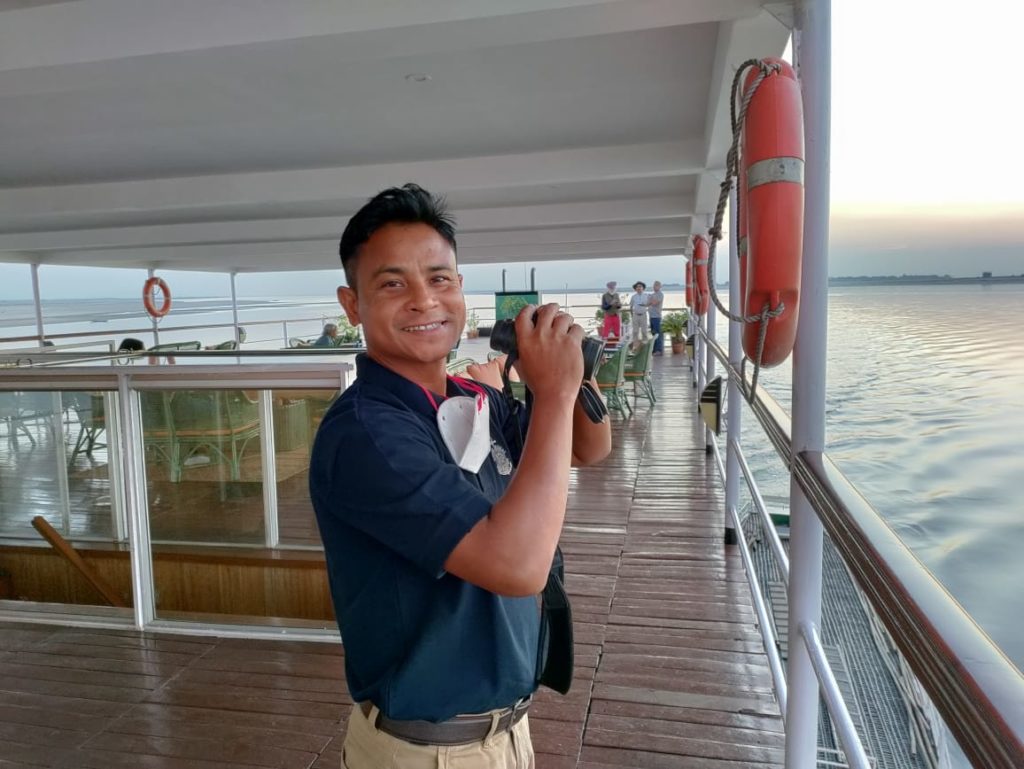
Naturalist Babajaan always on the lookout. * Photo: Hema Maira
We were often rewarded with wonderful sights while Brahmaputra River cruising. We saw a majestic osprey gorging on its catch, and a few pairs of mate-for-life Brahminy ducks drifting in the shallows.
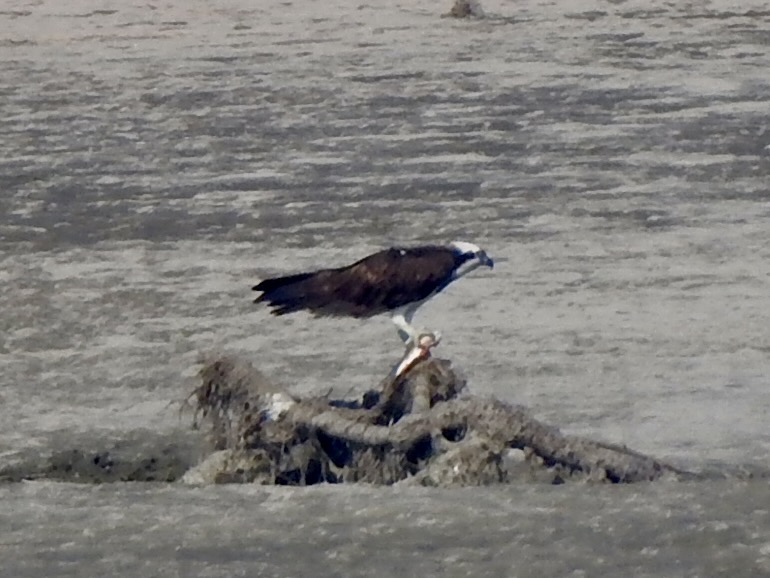
The white headed osprey as seen from the boat. * Photo: Gautam Mehra
On other occasions, we spotted a motionless spotted grey heron transfixed, attempting to snag its prey, and a solitary eagle voraciously feeding while sitting in the sand.
Many bodies were leaning out over the handrail hoping for a sight of a Gangetic dolphin (Platanista gangetica gangetica), that most elusive of all creatures.
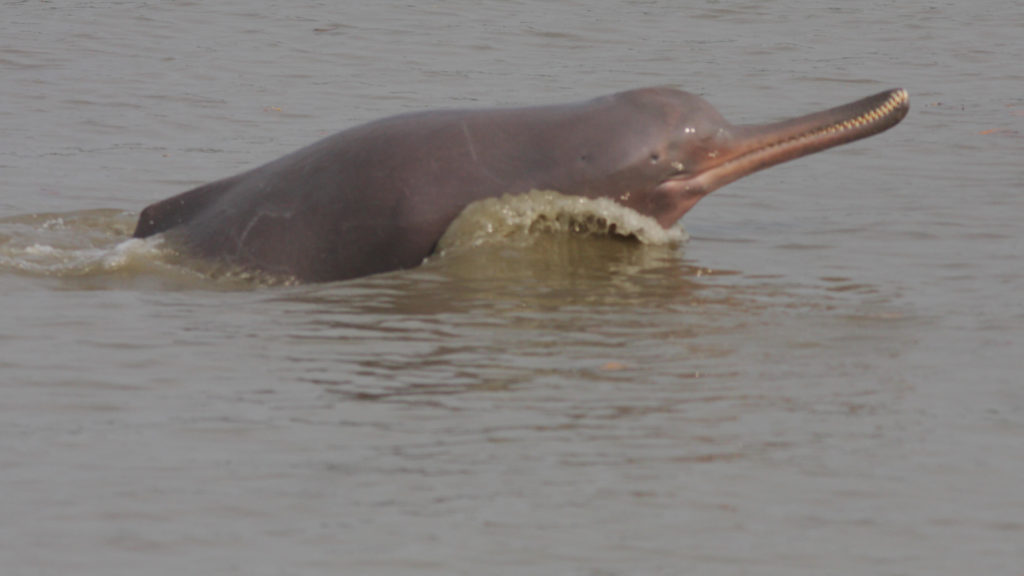
A Gangetic dolphin. * Photo: Zahangir Alom / Marine Mammal Commission / National Oceanic and Atmospheric Administration – Freshwater Dolphins and Porpoises. Marine Mammal Commission., Public Domain, https://commons.wikimedia.org/w/index.php?curid=64140381
The brevity of the moment makes it hard. As a dolphin comes up to take a breath only to dive back into the water, the sighting, if at all, is necessarily only a fraction of a second long.
It is one rapid, fluid moment. If you are lucky, you catch it! Some of us were. I had one sighting of that familiar arched back before it disappeared — no chance for photos! A thrill all the same!
A Love Affair with Wildlife
I became a wildlife enthusiast decades ago. Chaperoning a fifth-grade school trip in 1984 to Ranthambhore National Park in Rajasthan, India, proved unexpectedly fortuitous.
Ranthambhore, arguably the best place on the planet to sight the Royal Bengal tiger in the wild, has been the equivalent of my second home ever since.
Consequently, most of my travel has been geared to exploring nature reserves or tiger parks.
With a near-obsessive focus on tracking tigers (I co-authored a book for school children called Looking at the Tiger), I have visited numerous National Parks in India, including Panna, Pench, Tadoba, Bandhavgarh and Kanha in central India; Pilibhit, Dudhwa, Corbett and Rajaji in northern India; Kaziranga, Manas and Pakke in northeastern India; and Kabini, Nagarhole and Mudhumalai in southern India.
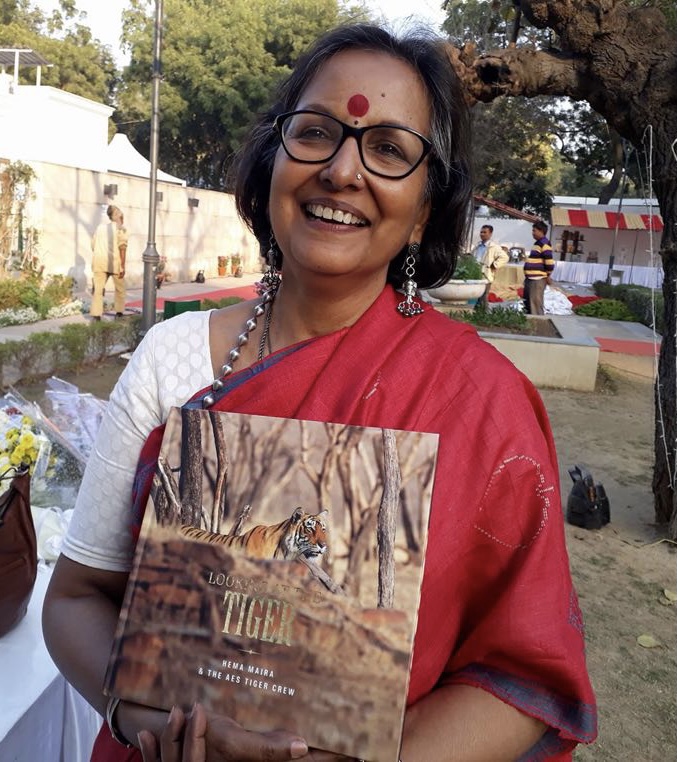
Hema with the book she co-authored, “Looking at the Tiger.”
Introduced to birding while visiting passionate birder friends in South Africa in 1999 widened my wilderness repertoire. I have been actively pursuing an increasingly passionate love affair with the wondrous avians of our planet ever since.
I love wildlife and the natural world, and am at my happiest in the great outdoors!
Under the River’s Spell
The magic of the mighty Brahmaputra River engulfed me. Growing increasingly fascinated by all I saw and heard, I felt an immense desire to learn more about this bewitching, captivating river.
I found myself wanting to experience the different aspects of this river as it traversed its course. From its tumultuous meandering and its capricious dancing, roaring, tumbling on the one hand, and its Arcadian tranquility on the other.
To traverse more, or all, of the Brahmaputra’s epic journey from its birth in Tibet until it is subsumed into the Bay of Bengal has become a personal goal.
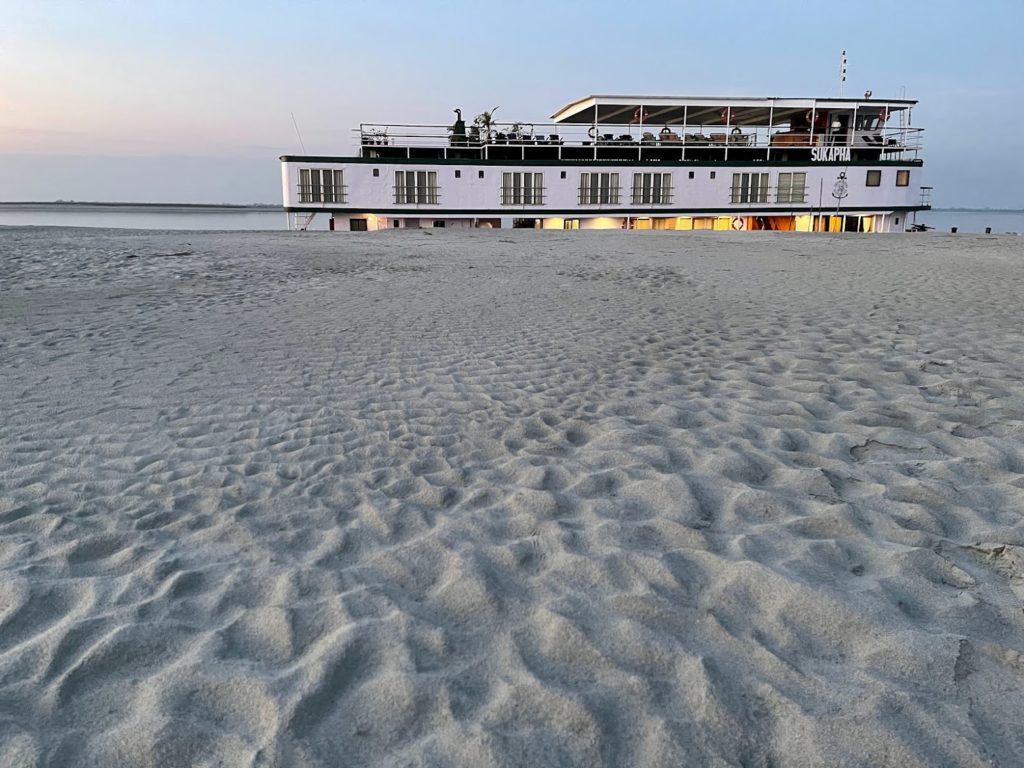
The Sukapha anchored along the Brahmaputra’s sandy shores — serenity personified. * Photo: ABN
SIDEBAR: Recommended Reading
- The Braided River, a Journey along the Brahmaputra, by Samrat Choudhury
https://harpercollins.co.in/the-braided-river-a-journey-along-the-brahmaputra-by-samrat-choudhury/
https://www.telegraphindia.com/culture/books/review-the-braided-river-a-journey-along-the-brahmaputra-by-samrat-choudhury/cid/1839553 - Interview with Samrat Choudhury, author of The Braided River
https://scroll.in/article/997760/interview-the-braided-river-author-samrat-choudhury-on-writing-about-the-brahmaputra - The Unquiet River, by Arupjyoti Saikia
https://www.amazon.in/Unquiet-River-Biography-Brahmaputra-ebook/dp/B08642WN2Q
https://www.goodreads.com/book/show/49046695-the-unquiet-river - River at the Heart, by Arati Kumar-Rao
https://emergencemagazine.org/essay/river-at-the-heart-of-the-world/
Meals Onboard on Sukapha
The dining room, cheerful and spacious with wide glass windows on either side, ensured great views and plenty of light. There was free seating at tables of four or six. One larger table accommodated 10.
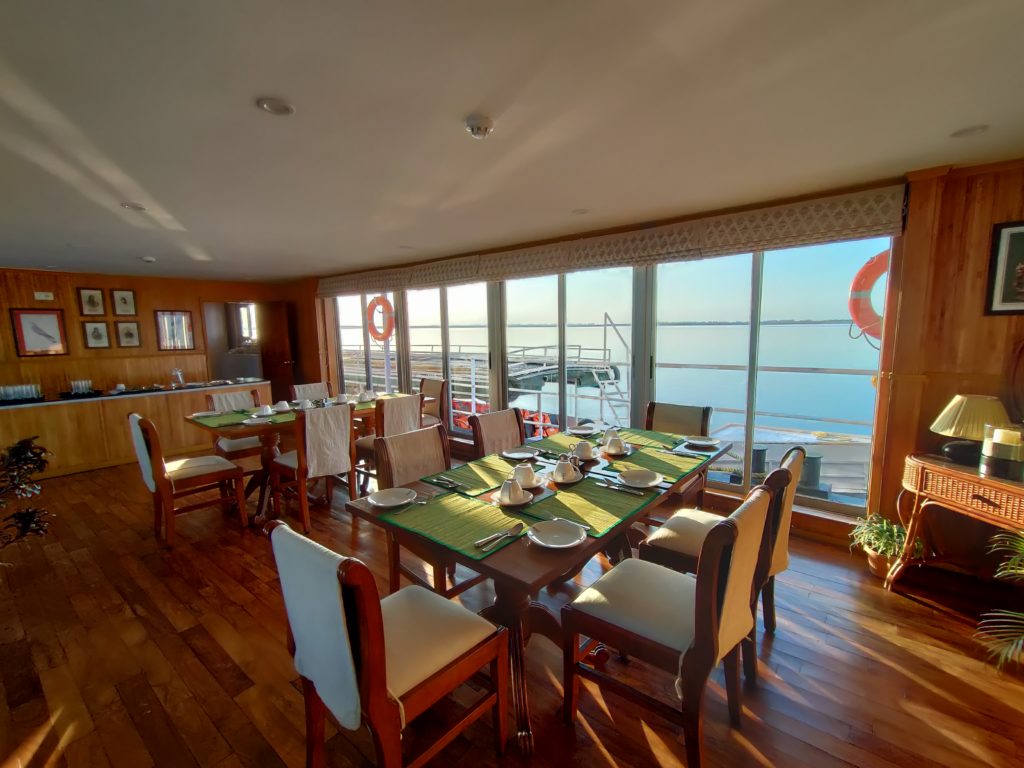
The Sukapha’s very pleasant dining room. * Photo: Hema Maira
Breakfast offered western and Indian options.
Lunch and dinner varied between Indian, Assamese, Bengali, Chinese and continental offerings. Both meals would begin with a soup and there was a generous offering of a variety of different options.
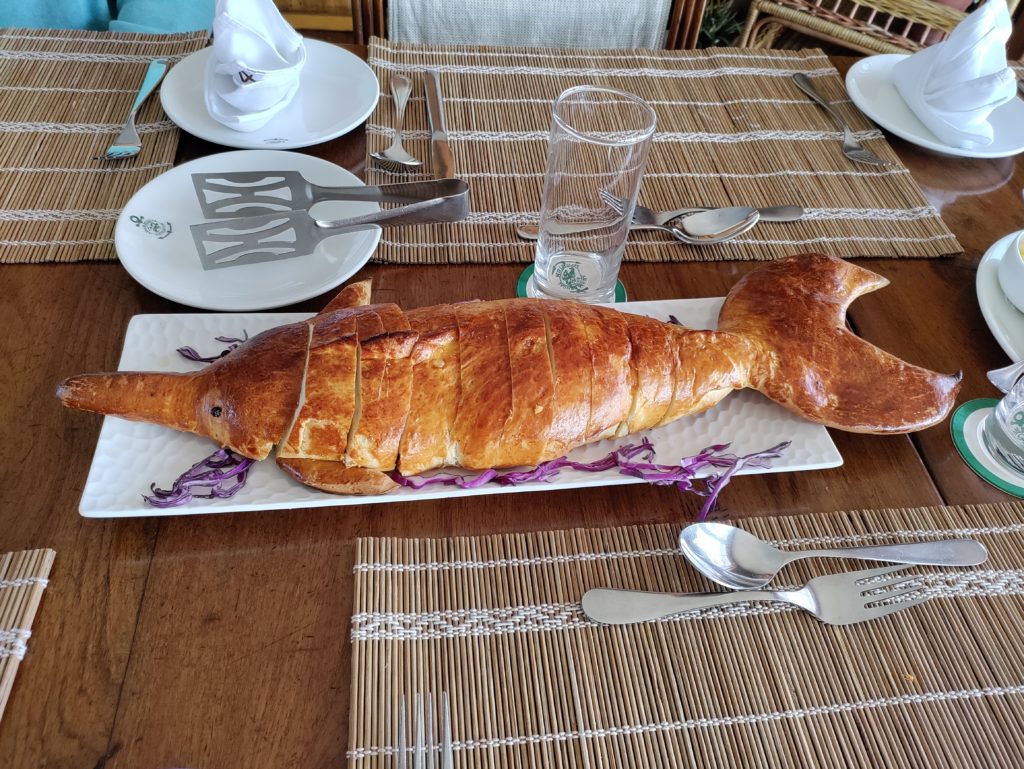
What a delight! Dolphin bread. * Photo: Hema Maira

Culinary creativity in fish-shaped cutlets. * Photo: Hema Maira
I particularly enjoyed the local Assamese cuisine. The flavour of fish tenga, a tangy fish curry, and alloo pitika, a delicious version of mashed potato, remain on my taste buds.
Beer and wine were available for sale through the day.
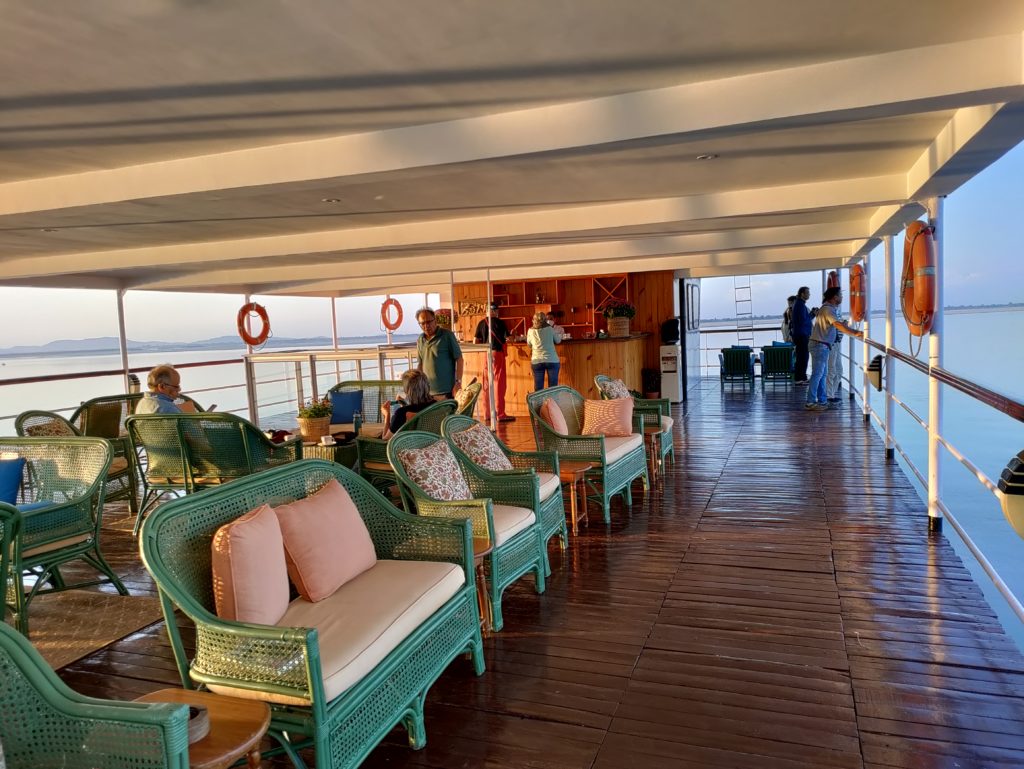
Evening light on the top deck, the perfect place for libations and convo. * Photo: Hema Maira
The meals were served freshly cooked, hot and were delicious. The servers were polite and gentle, and kept a keen eye out for individual needs including specific dietary requirements.
Brahmaputra River Cruising Daily Schedule
The schedule had been thoughtfully planned and consisted of a daily on-shore activity for a couple of hours. Sailing for the remainder of the day, we would moor at a pre-determined spot at sundown.
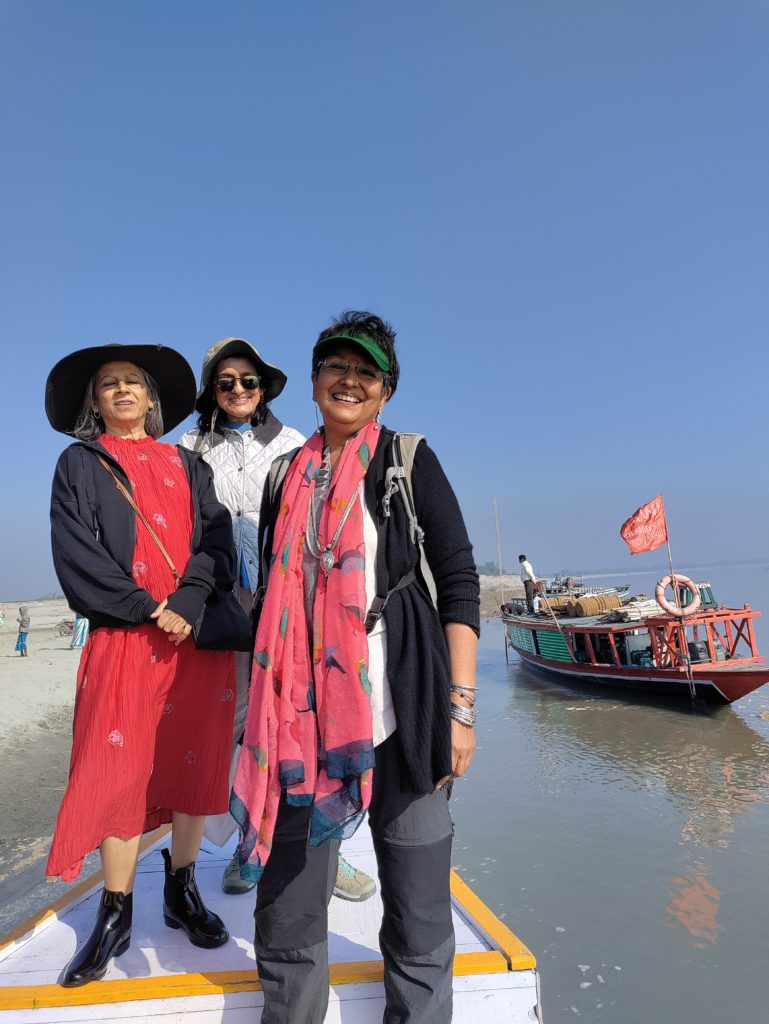
Hema and her friends at the bow of the tender that shuttles passengers between the anchored Sukapha and shore points. * Photo: Hema Maira
A charming dance performance by Bodo girls and boys; a demo of sericulture, the process of producing raw silk by raising silkworms; and visits to a WWII cemetery, a fifth-century temple, and Cole Park, established in 1906 by a Britisher, were among the offerings.
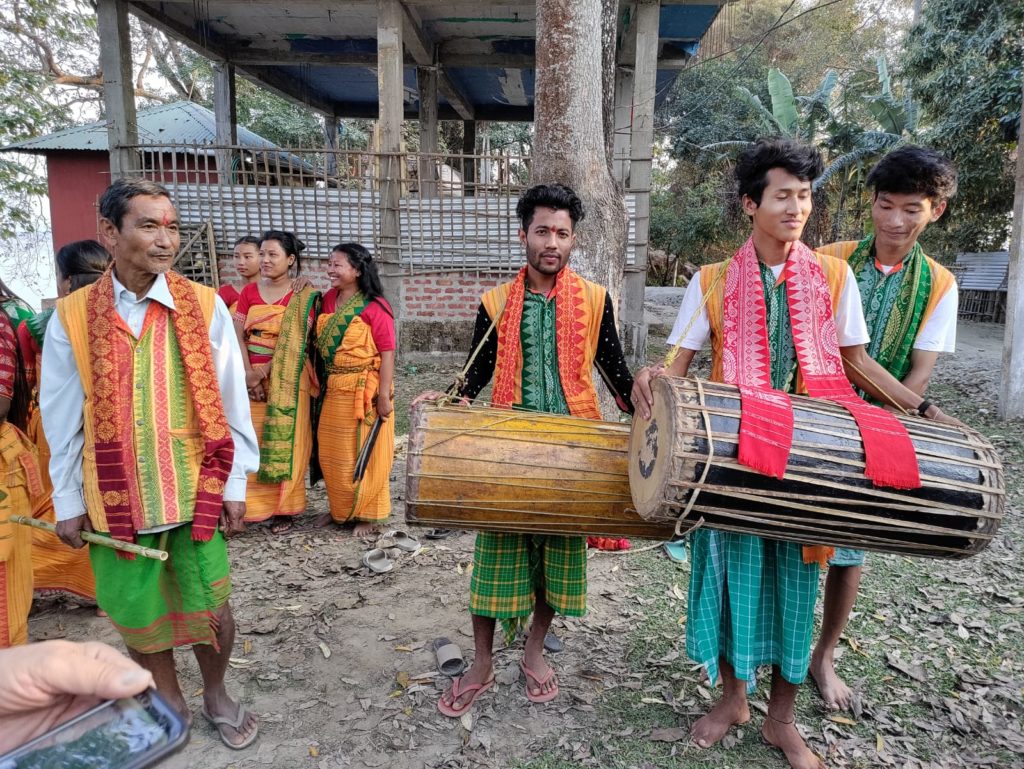
Local dance performers. * Photo: Hema Maira
While most folks felt the visit to the cemetery was worthwhile, there were mixed reviews about the visit to the temple and Cole Park. Some felt there was not enough to see around there. The other outings were appreciated by all.
I found our visit to Khirakati, a big island that supplies 50% of Guwahati’s vegetables, fascinating. We had a delightful walk around the island.
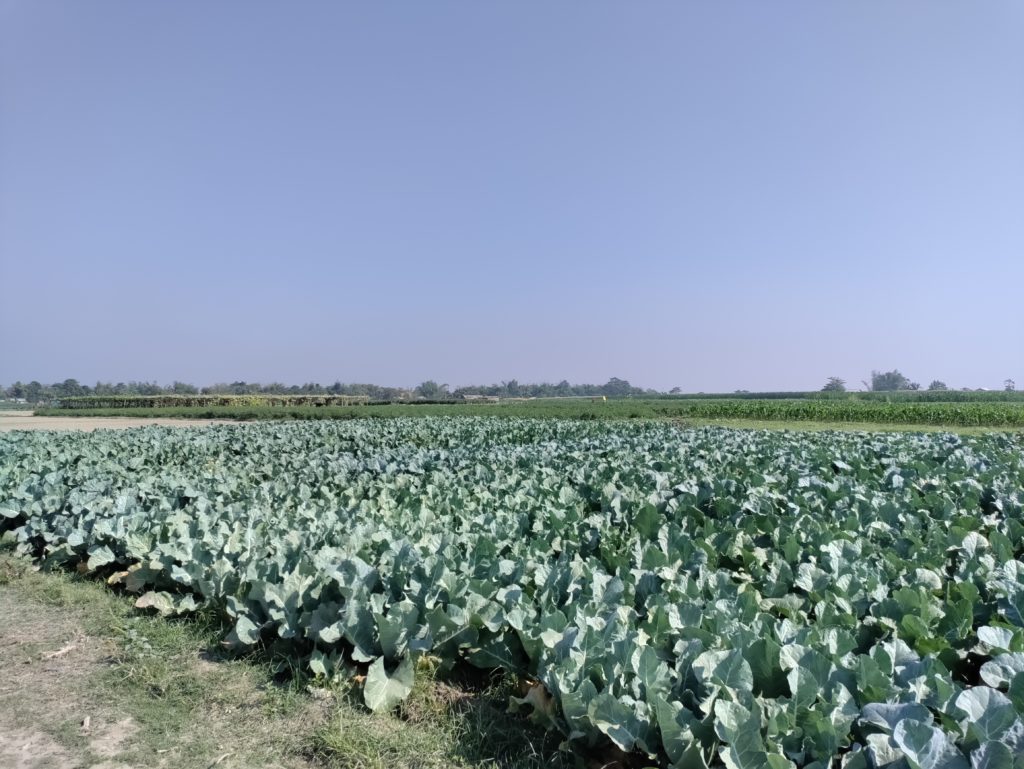
Vegetables galore on Khirakati. * Photo: Hema Maira
Marveling at the expanse of the fields and the large variety of vegetables grown, I tried to imagine the backbreaking toil this must entail since most labor is manual.
Uncertainty looms large as the island constantly gets eroded and rebuilt by the vicissitudes of the river. Life for the residents is hard, yet they match the implacable, unrelenting river with dogged persistence.
As we were walking through the village, we saw a woman bathing a little girl and sitting beside them another woman combing a child’s hair. It was a private moment and it seemed like our presence was an intrusion.
I remember some of us debating the rights of tourists and the point at which tourism becomes an “intrusion.”
The benefits of tourism for the local population versus possible negative impacts is a conundrum to which I have not yet found an answer.
Rafting Wasn’t Meant to Be
The plan was to go rafting one morning, an activity I had been looking forward to since I read it on the schedule.
Our destination was the river Jio Bhorelli, which runs through Nameri National Park. A drive of about an hour and a half got us to our starting point.
As we started rafting gently down the river, we soaked up the pristine wilderness around us and the forest-clad mountains in the distance.
We could have been anywhere in the world.
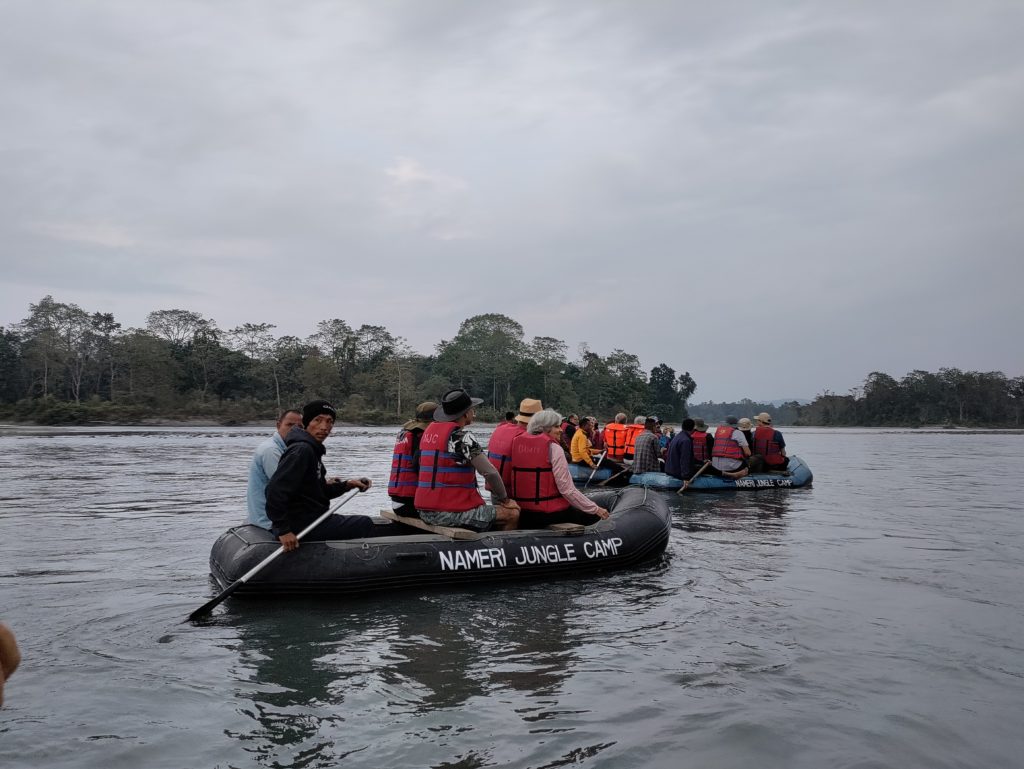
Attempting rafting at Nameri. * Photo: Hema Maira
Unfortunately shortly after we started it began to rain. After two attempts at taking shelter, waiting and hoping for it to clear up, the consensus was to abort the rafting trip.
A hot breakfast later, we went to visit a Mishing village close by. The people were welcoming and friendly. I appreciated the authenticity of viewing everyday life as we wandered through the charming hamlet.
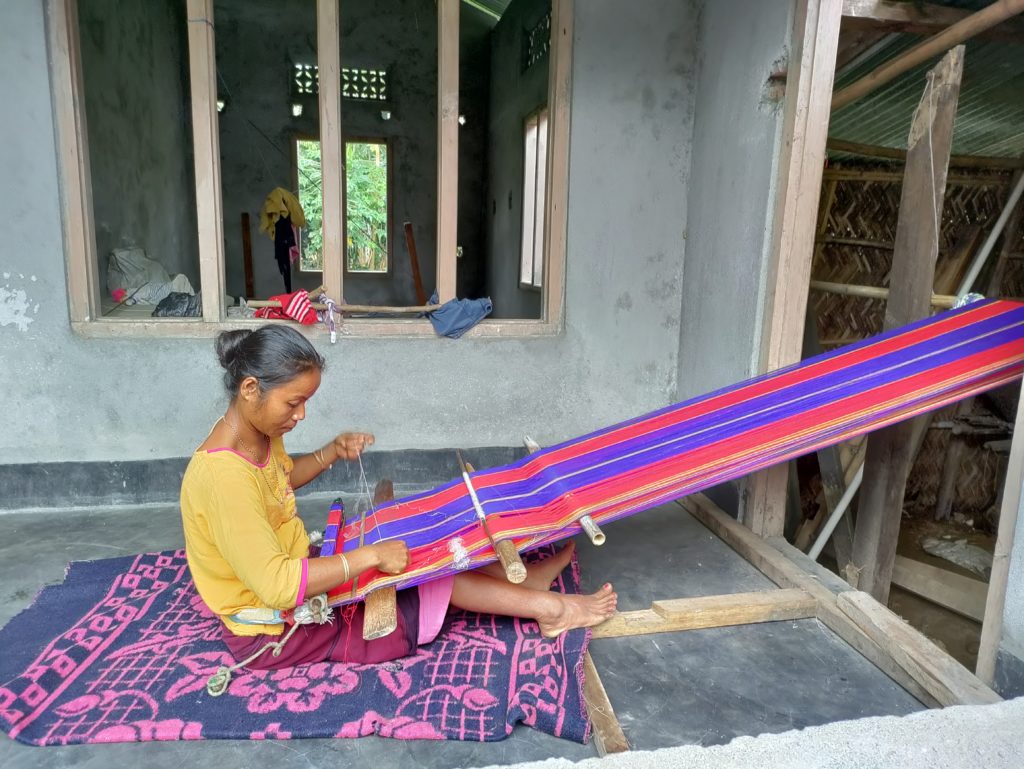
Mishmi village weaving. * Photo: Hema Maira
Brahmaputra River Cruising is all about Relaxing on Deck
Afternoons and evenings were spent on the sun deck. Lazing in splendid isolation or in small groups, languorously stretched out on a lounger, curled up on one of the sofas or simply leaning on the handrail staring out in deep contemplation.
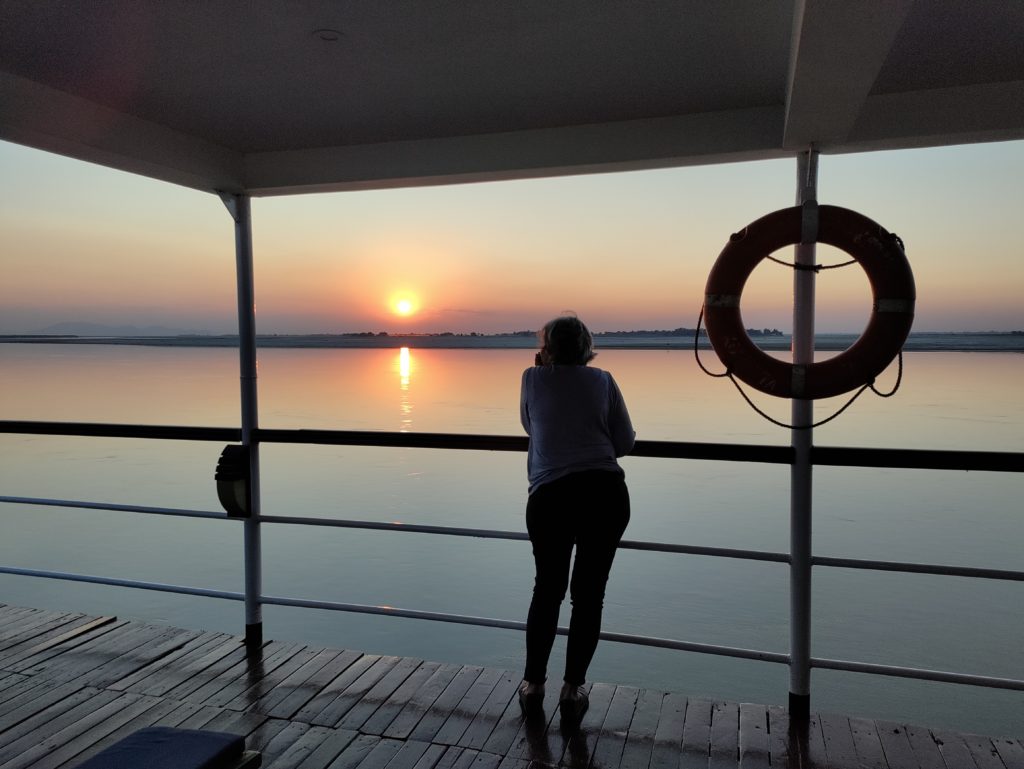
Contemplation on deck. * Photo: Hema Maira
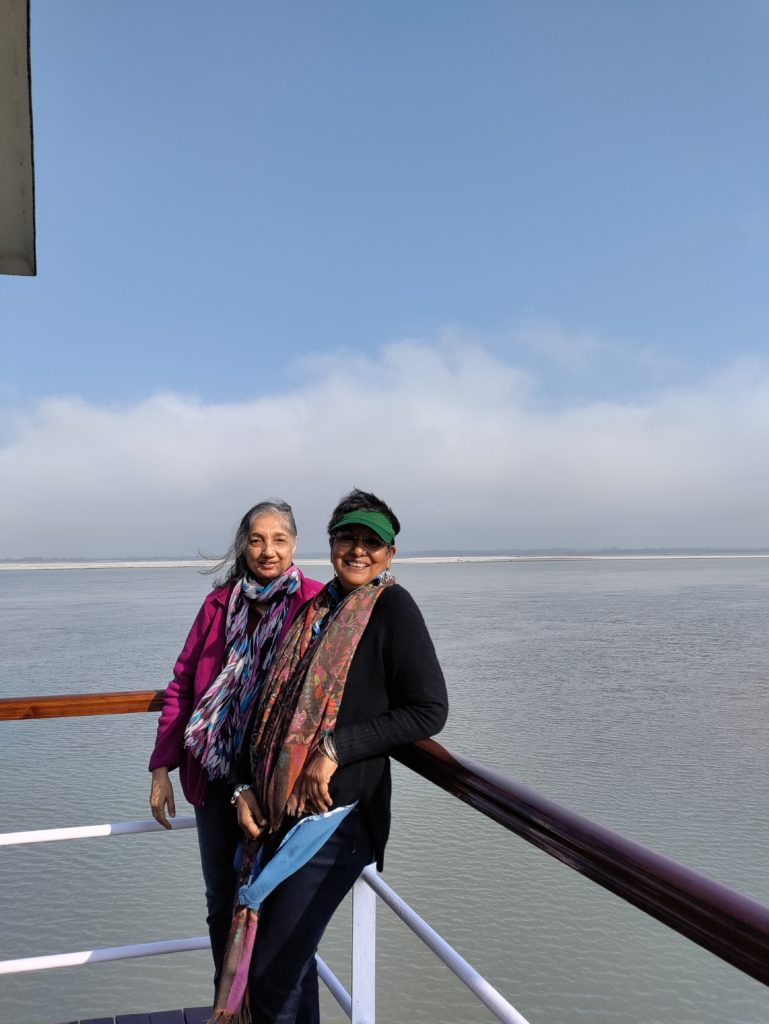
Amita & Hema enjoying the view from deck. * Photo: Hema Maira
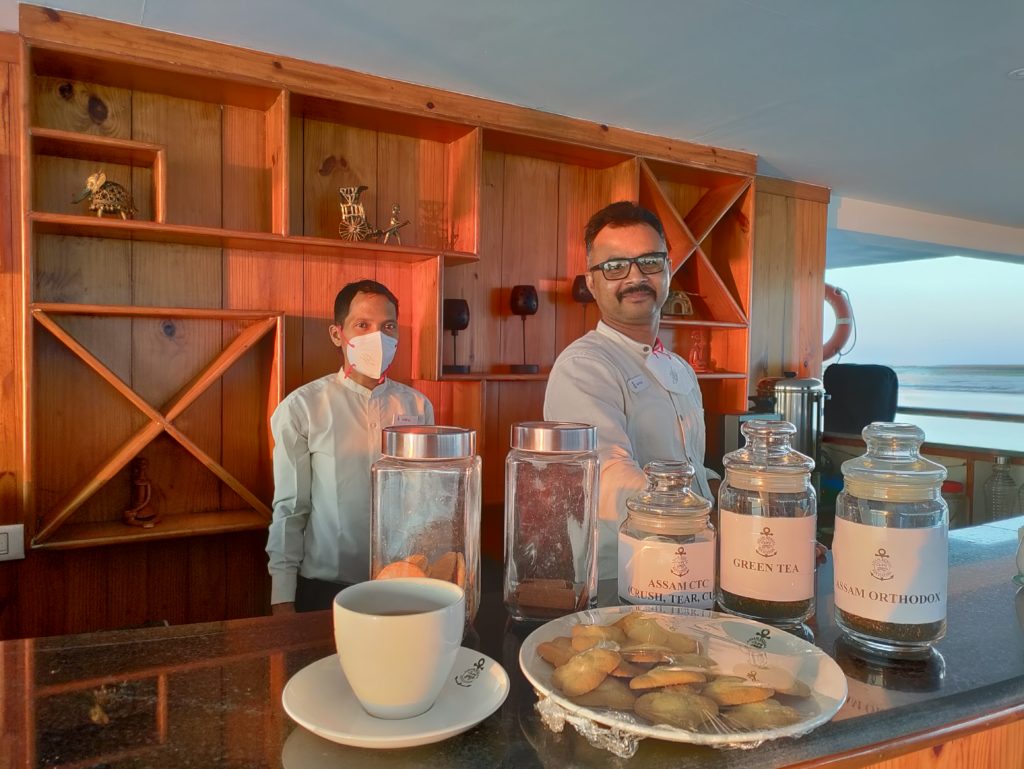
Tea served on deck when the lighting was just right. * Photo: Hema Maira
Evenings were enchanting as the great golden orb descended in a flame of glory painting the sky with a palette of breathtaking hues ranging from pinks, purples, oranges, reds and yellows.
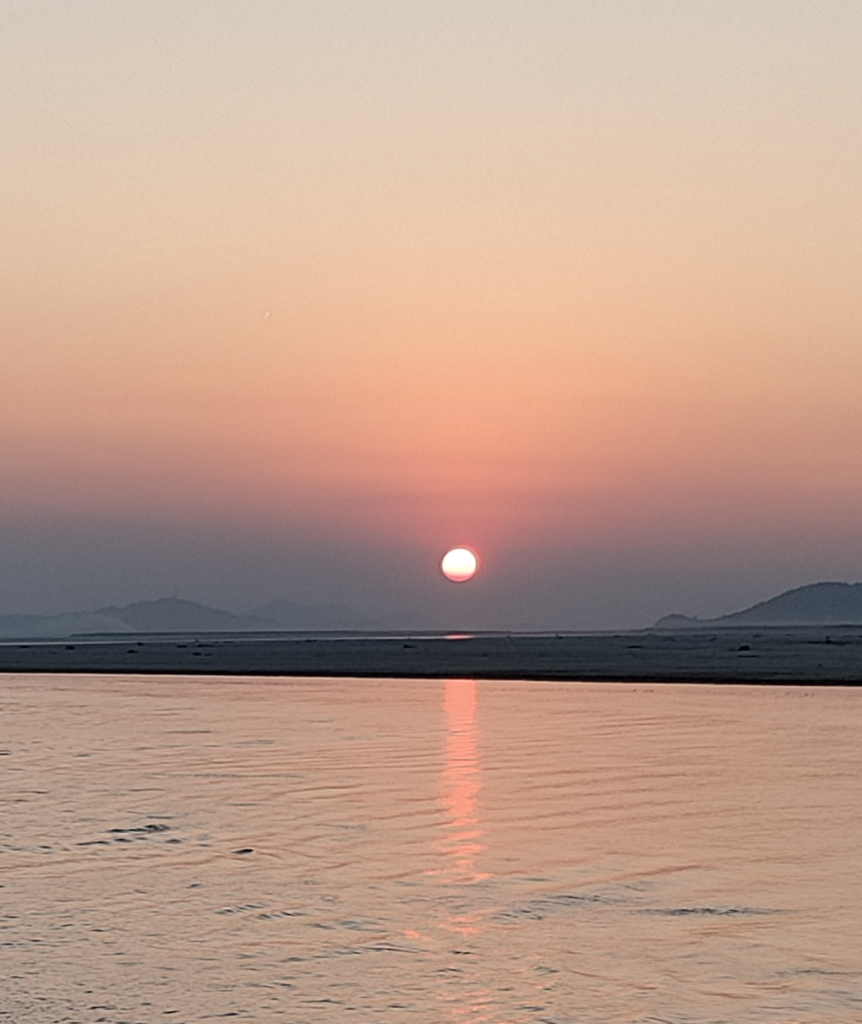
The Brahmaputra sunsets were spectacular. * Photo: Hema Maira
Evening Presentations
There was a slide show presentation every evening. We learned about the Brahmaputra; Northeast India, which is also known as the Seven Sisters; and Kaziranga National Park.
I was riveted and learned a lot. Armed with a host of new facts, I felt a strong kinship to this remarkable river.
Contextualizing it not only in geographical and historical terms, but closer to home, I was able to develop a clearer idea of what it signified for the people of Assam and the wildlife of Kaziranga.
Mandy shared info on a couple of Ibex-curated trips to Peru and Chile, which served to whet my appetite. We also heard about the Responsible Traveler campaign Mandy has been a part of as founder and president of the Responsible Travel Society of India.
For one who believes in keeping a light environmental footprint, I loved watching firsthand how committed Mandy and Anita, and hence Ibex, are to the same.
Barbecue Dinner — One of the Trip Highlights
Pitch blackness, a resplendent sky and silence all around, made for mesmerizing nights on the river.
Kunal, the manager and his team on Sukapha, had a treat in store for us one night — a barbecue dinner on a sandbank!
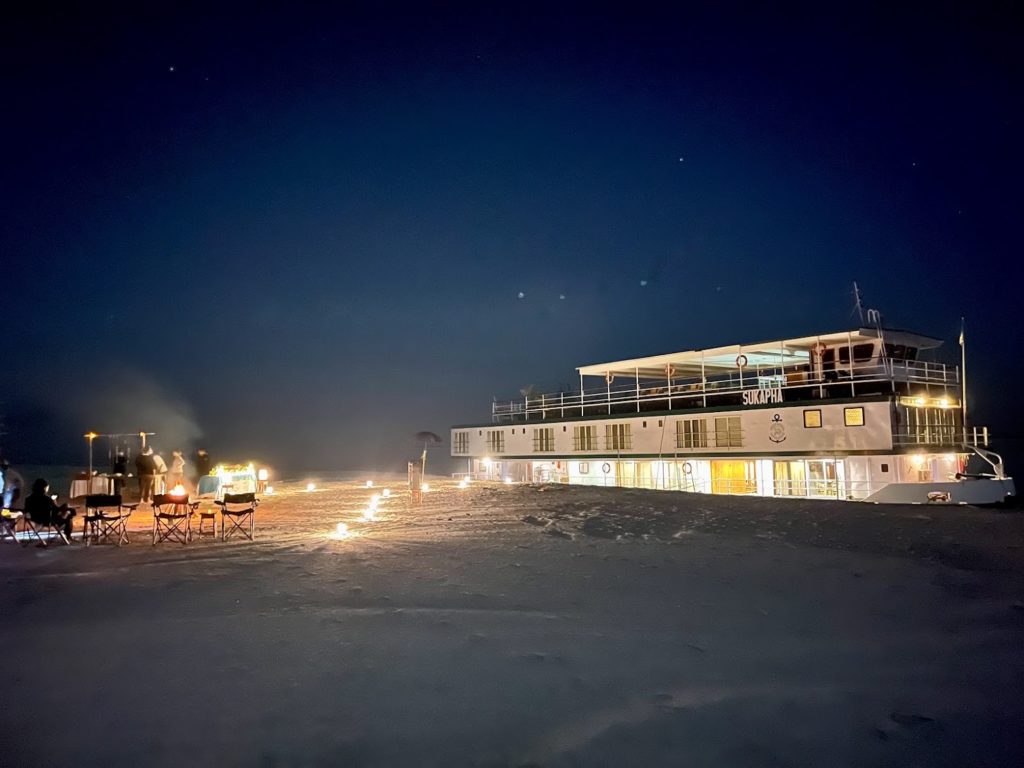
An evening of drinks & dinner on the sandy banks of the Brahmaputra. * Photo: ABN
With decorative lights on the sand, a barbecue station, a full-fledged bar and a music system (though I would have preferred the quiet and natural sounds!), they had converted a sandbank into a veritable fairyland!
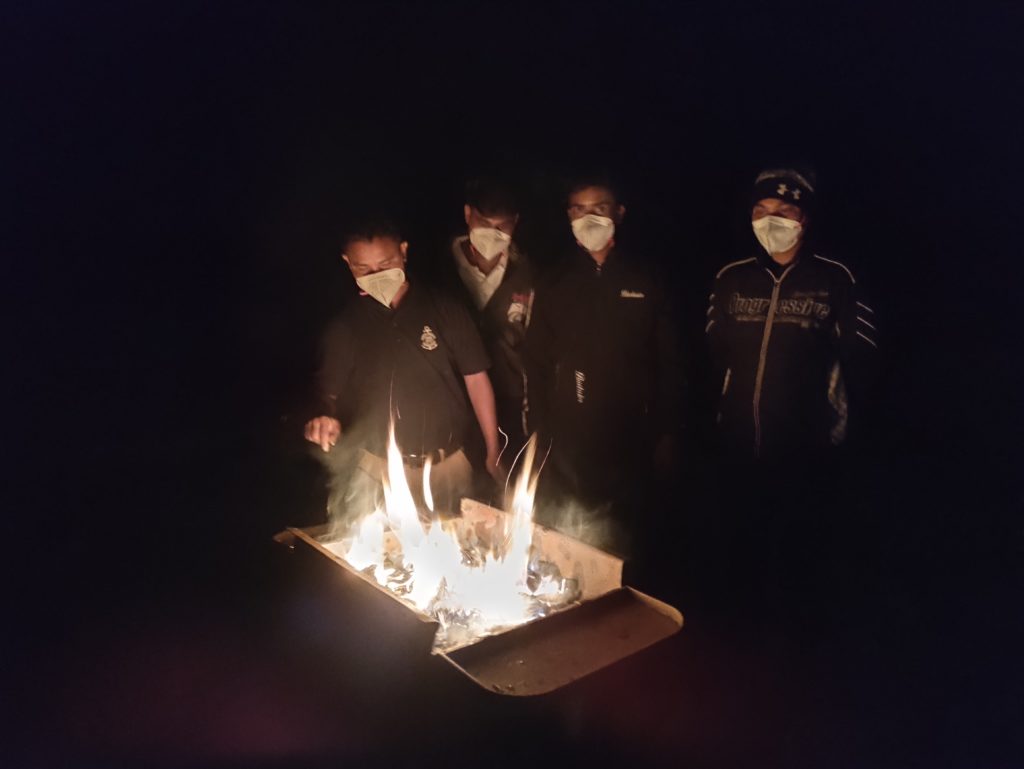
The magical barbecue evening. * Photo: Hema Maira
We bought our own drinks while food came around on trays. We enjoyed piping hot, freshly barbequed meats (mutton, chicken and fish), vegetables — stuffed potatoes, home-made Indian cottage cheese known as paneer, mushrooms, bell peppers, dal (lentils) and rotis (Indian bread) — and dessert.
Mouthwatering and delectable! We ate and drank until we were sated and then some.
We were lucky with the weather. The fog often came in by the time the sun started to set, but this evening was clear.
A picture-postcard setting!
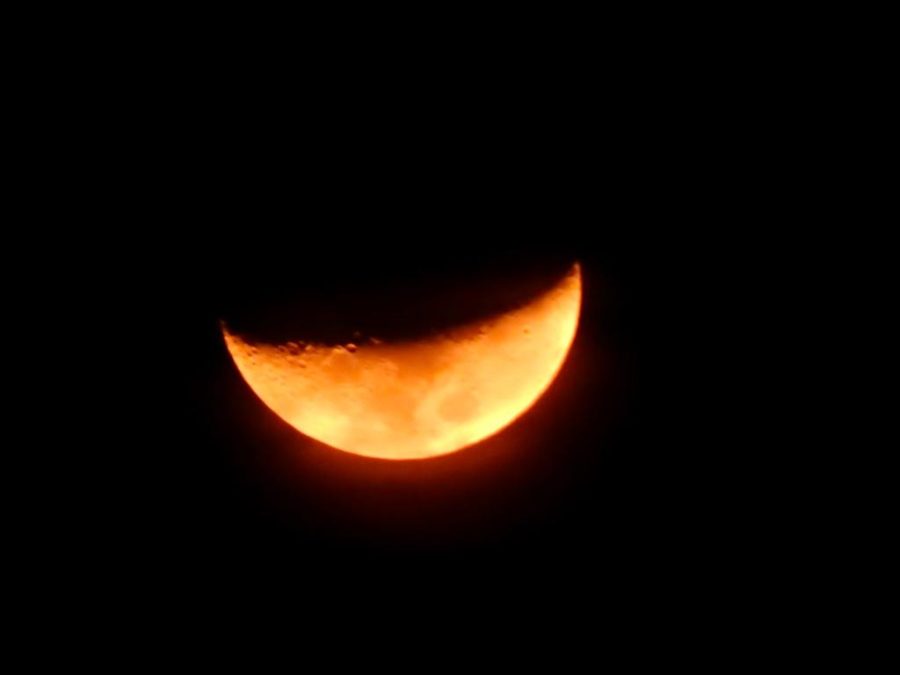
What a night! A sliver of orange-y moon to gaze at. * Photo: Gautam Mehra
The sky was at its most magnificent — a sliver of moon, the resplendent Milky Way and the occasional cloud, in back-lit glory, as it floated past the moon.
What more could one ask for?!
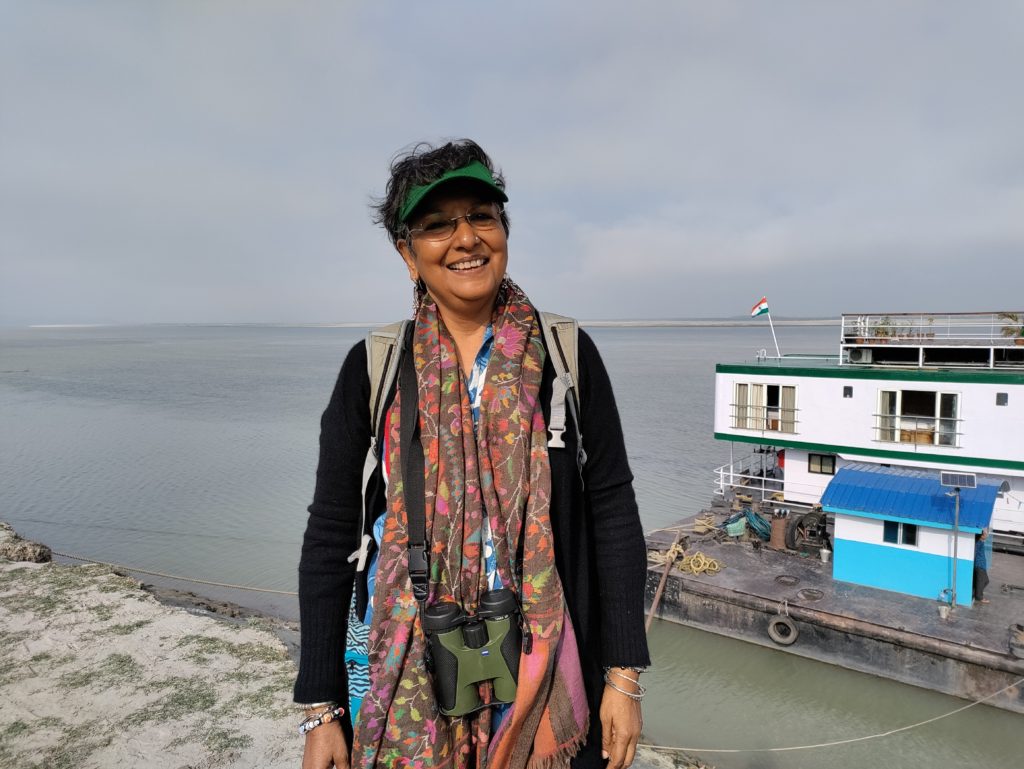
Hema disembarking the Sukapha on the last morning. * Photo: Amita Talwar
RELATED: Read all about Heidi’s Brahmaputra River cruise adventure here.
Our Post-Cruise Land Trip — Next Stop Kaziranga National Park
Our last day on the boat dawned all too soon. The crew had all lined up to say goodbye as our bags were loaded onto the Tempo Travellers mini busses.
Most, if not all of us, would have been happy with another day on board; a testament to Anita and Mandy’s effort and organization.
A distance of 45 kilometers or so would take us just under an hour by road from Silghat to Kaziranga.
Tea Estate Visit
En route to Kaziranga, we stopped at the Koliabor Tea Estate, for an informative 30-minute presentation. We couldn’t be in Assam and not learn about tea!
With a history of almost 200 years, Assam tea is world-famous for its strong, bright colour and full-bodied, robust flavor.
It was a crisp, clear, picturesque day and an enjoyable experience.
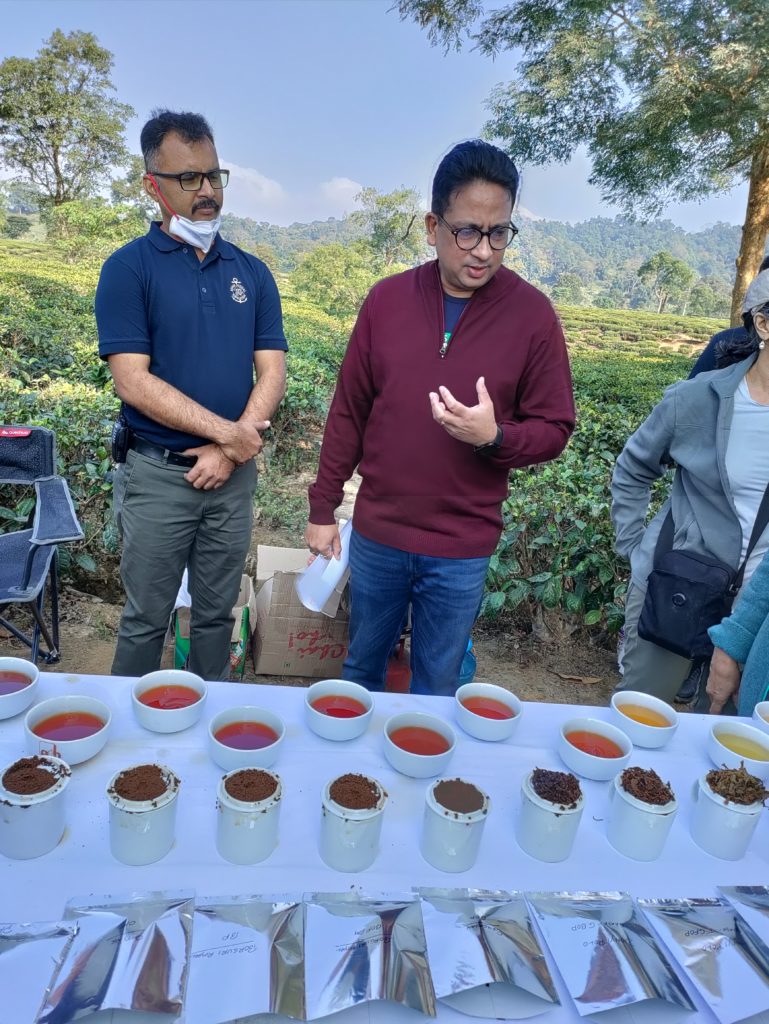
The tea table in Koliabor. * Photo: Hema Maira
Kaziranga National Park
A UNESCO World Heritage Site, Kaziranga National Park covers 430 square kilometers.
It is famed for its population of greater one-horned rhinos (also known as the Indian one-horned rhino), which, numbering 2,413, constitutes approximately two-thirds of the total world population.
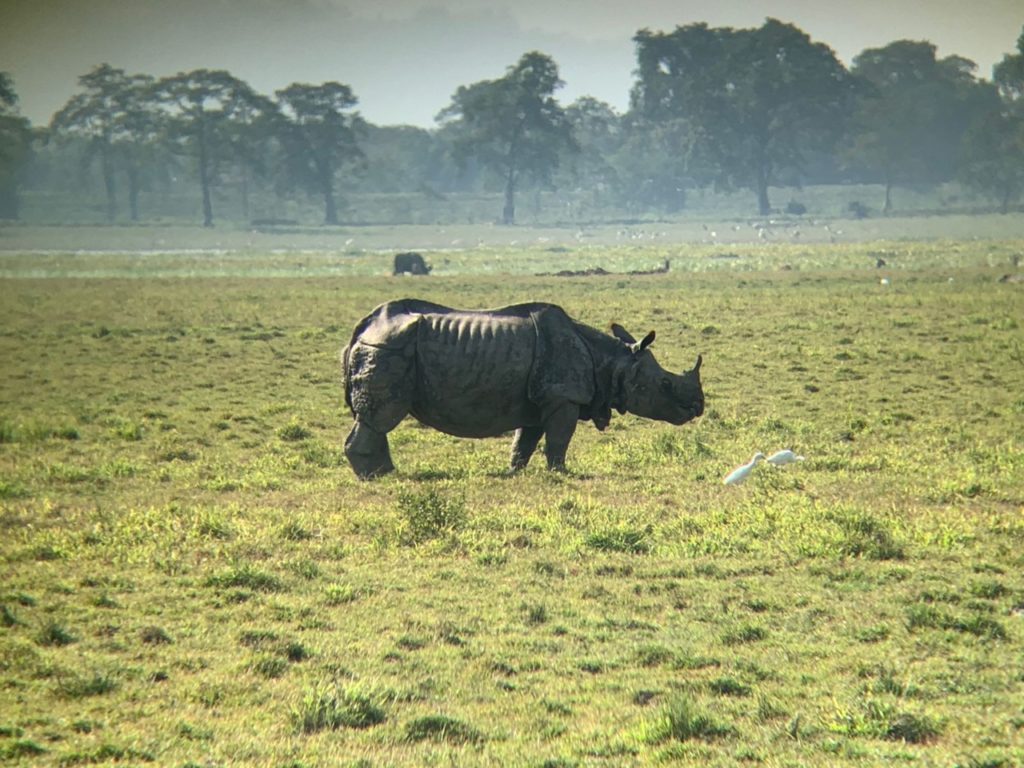
The famed one-horned rhinos of Kaziranga. * Photo: Poonam Bhagat
Kaziranga boasts a variety of disparate vegetation. Tall elephant grass, inundated grasslands, swampy woodlands and dense forests provide ideal habitats for the diverse wildlife here.
The animals living in and around the park include hoolock gibbons, swamp deer, Indian elephants, tigers, leopards, wild water buffalo, turtles, fish, reptiles and sloth bears.
A bird watcher’s paradise, Kaziranga is also home to more than 475 species of birds, both resident and migratory.
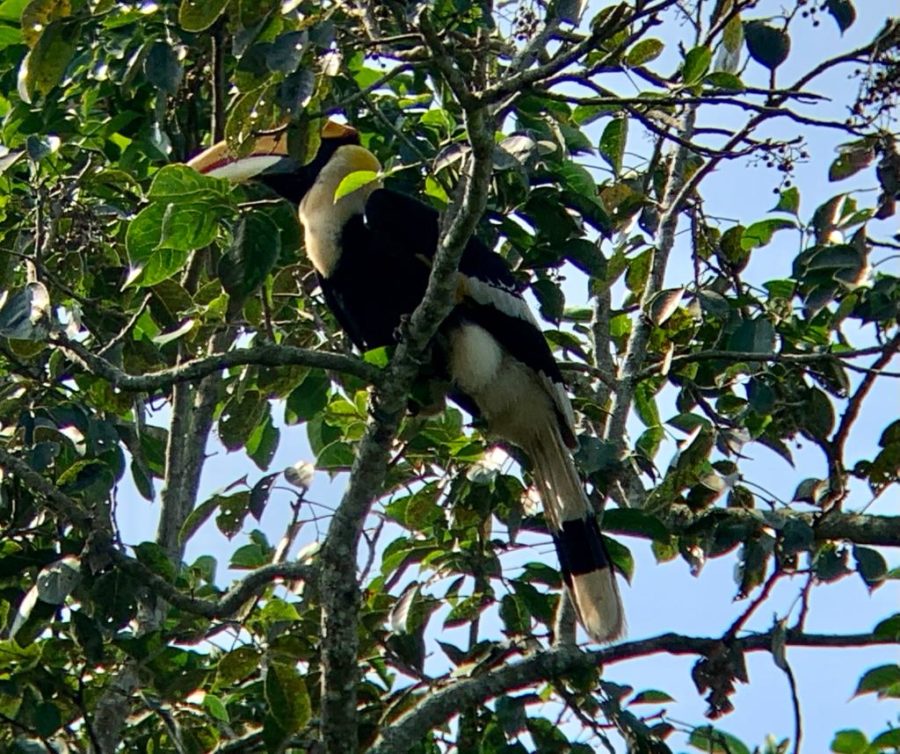
A Great Indian Hornbill. * Photo: Poonam Bhagat
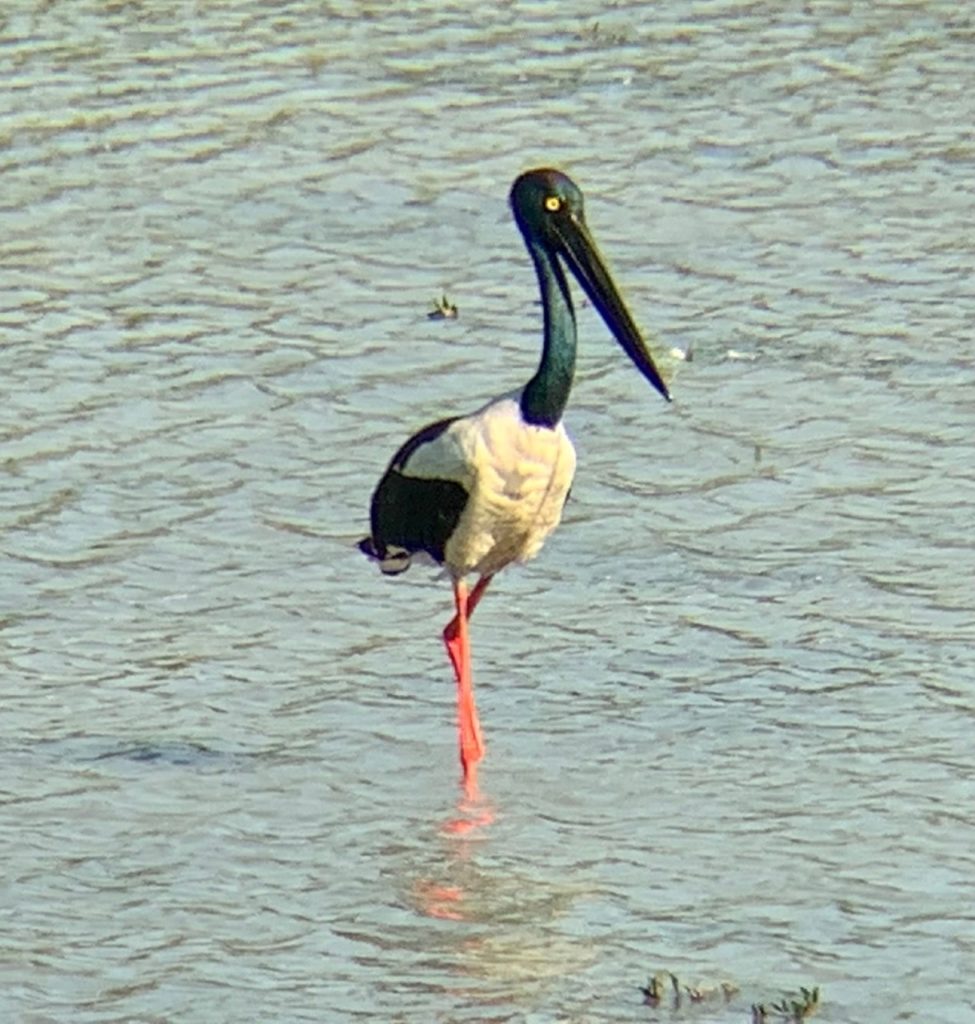
A black-necked stork. * Photo: Poonam Bhagat
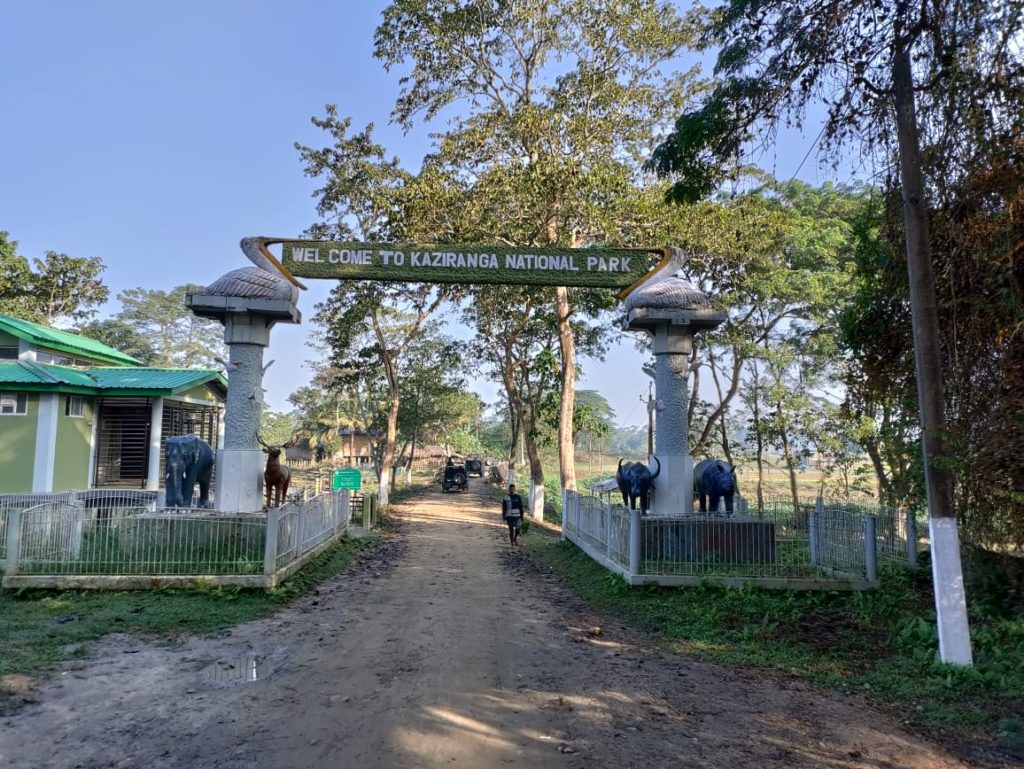
The entrance to Kaziranga National Park * Photo: Hema Maira
Looking Out for Hoolock Gibbons
Near Kaziranga we got to see where hoolock gibbons, the only ape native to India, are sometimes seen.
We were lucky to have a great sighting. Gibbons are arboreal (living in trees) and we watched the antics of a few of them cavorting and gamboling among the high branches with the innate ease and dexterity typical of apes.

We were lucky to spot a Hoolock Gibbon, a female! * Photo: Gautam Mehra
The gibbons hefted themselves, hurling their bodies with unerring accuracy from vine to vine (sometimes over a fairly long distance), using their long arms to swing acrobatically from tree to tree.
The original trapeze artists!
As very vocal creatures, the name “hoolock” comes from the sound of their calls.
Diphlu River Lodge
I had been to Kaziranga a few times before. My last visit recently, on the solo trip I mentioned earlier, though I stayed at a different hotel.
We arrived at Diphlu River Lodge around lunch time, our home for the next two nights. The property is expansive with well-maintained grounds. A veritable birdwatchers paradise.
The rooms were built on stilts and laid out individually, well-spaced from each other. Each room was spacious and had a pleasant rustic feel to it with its thatched roof, a good-sized sit-out (porch), and a large, en-suite bathroom.

A Diphlu River Lodge room. * Photo: Hema Maira
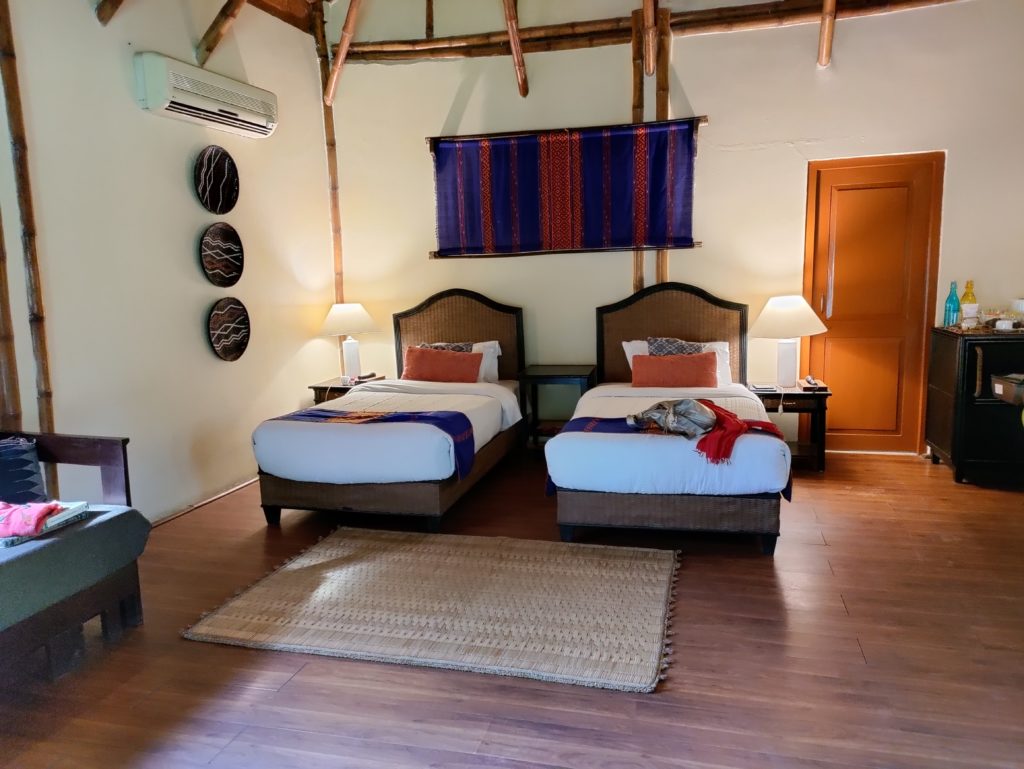
The interior of a charming Diphlu River Lodge room. * Photo: Hema Maira
I enjoyed staying at Diphlu and look forward to staying there again.
Their emphasis on being eco-friendly struck a particularly positive chord with me.
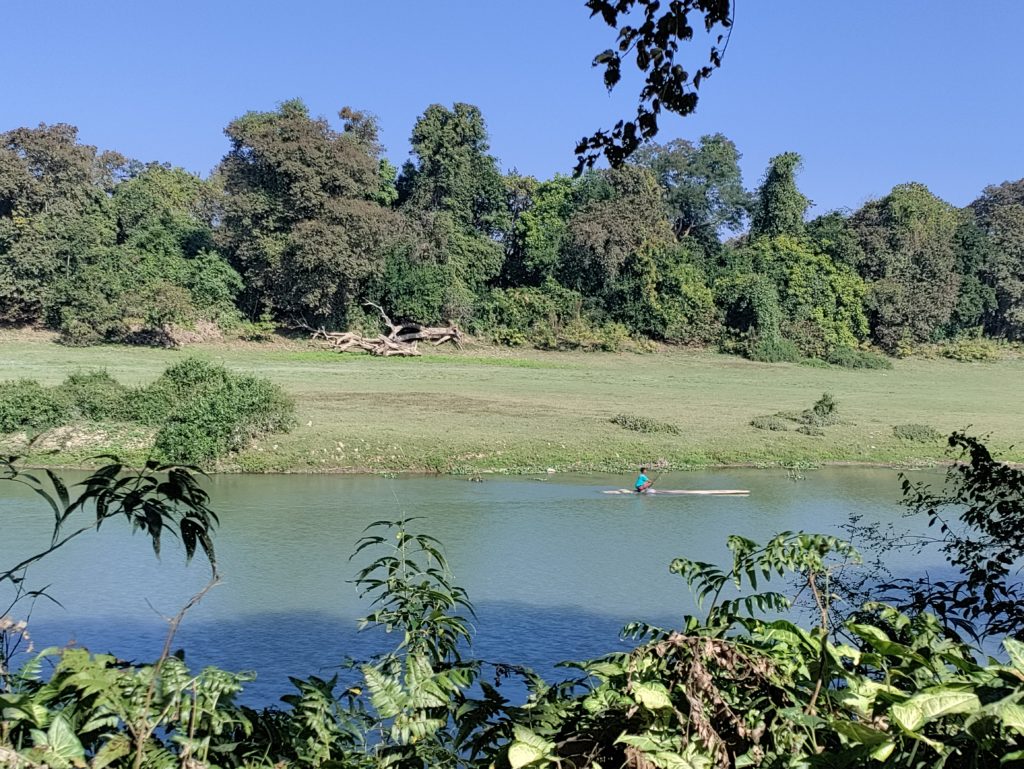
The Diphlu river. * Photo: Hema Maira
Jungle Safaris in Kaziranga
Wildlife safaris into the forest are done in open-top Maruti Gypsy jeeps. They seat six passengers, excluding the driver and guide. It is mandatory to have a guide with you on each safari.
There are two safaris daily. Timings vary depending on the season. In winter morning safaris are from 7:00am-12:30pm while afternoon timings are 1:30pm to 4:30pm.
We had four safaris covering a wide cross-section of the park and saw many of the famed one-horned rhinos and a host of other wildlife including Asian elephants.
VIDEO: Watch a family of elephants with their baby crossing in front of the road in front of Hema’s jeep.
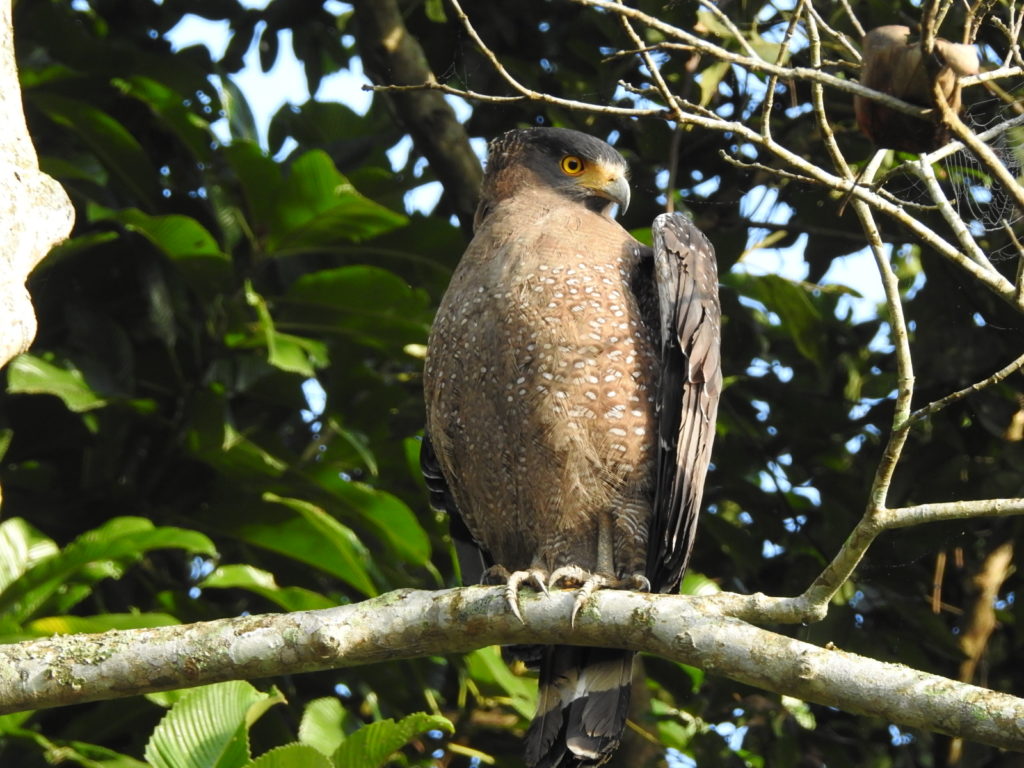
Crested serpent eagle seen in a tree. * Photo: Gautam Mehra
Elephant Safaris in Kaziranga
The Forest Department owns a number of elephants for patrolling the park.
An optional hour-long elephant safari is offered in the very early mornings — time slots are: 4:30-5:30 am or 5:30-6:30 am.
Once the safaris are over the elephants commence their patrolling duties.
The Forest Department is cognizant of, and careful about, ensuring their animals do not get exhausted or over-heated hence only two morning safaris are on offer.
There are a number of NGOs (non-governmental organizations) looking out for the welfare of these elephants as well. They keep a stringent eye out for any possible animal abuse.
That said, I am not in favor of elephant safaris. I believe animals should not be used for rides or other entertainment. Elephants go through a huge amount of trauma and abuse when they are captured and “trained” for domestic use.
The following quote from writer Henry Beston expresses my perspective eloquently:
“For the animal shall not be measured by man. In a world older and more complete than ours, they move finished and complete, gifted with the extension of the senses we have lost or never attained, living by voices we shall never hear. They are not brethren, they are not underlings: they are other nations, caught with ourselves in the net of life and time, fellow prisoners of the splendour and travail of the earth.” ― Henry Beston, The Outermost House: A Year of Life On The Great Beach of Cape Cod
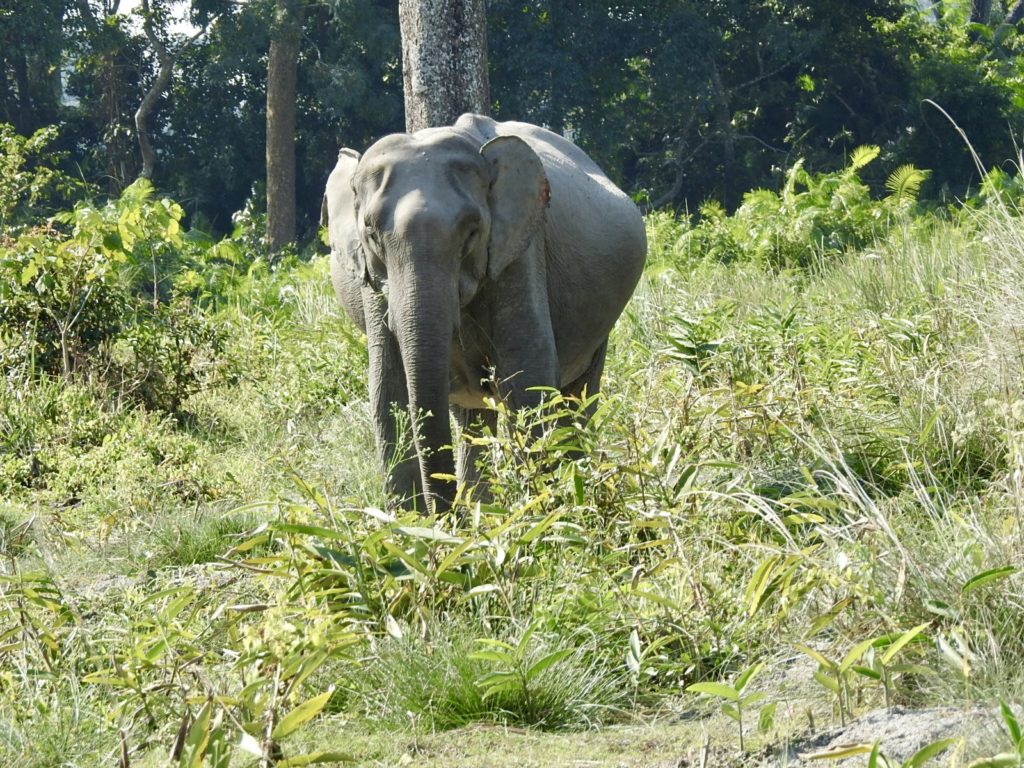
An Asian Elephant as seen from the jeep safari. * Photo: Guatam Mehra
End of Trip & Departure for Home
Our fourth and last safari was a shorter one due to the four-and-a-half-hour ride to Guwahati International Airport to catch our return flights.
It was now the end of a very well curated and wonderfully memorable trip.
I am now an Ibex fan through personal experience.
This was my first small-ship river cruise and I enjoyed it thoroughly.
It was good value for money and I look forward to my next small river boat cruise in the near future; in India or elsewhere in the world.
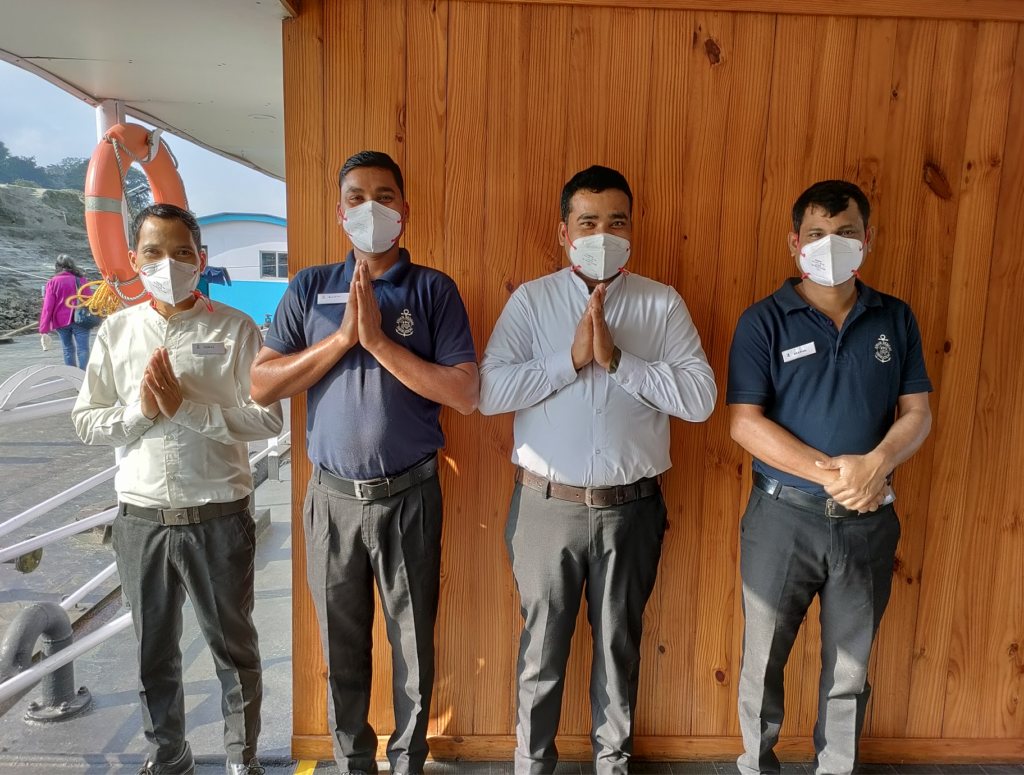
The crew saying good-bye. * Photo: Hema Maira
COVID NOTE: For our December (2021) cruise, it was mandated that we all be double vaccinated and undergo a RT PCR test 48 hours before departure. Additionally, I appreciated the fact that all crew members had masks on whenever they were on duty.
Sukapha Brahmaputra River Cruising Fares & Facts
Fare for Indian nationals on the Dec (2021) cruise:
- Fares start at Rs. 169, 500 per person on room sharing basis + 5% GST
- Single supplement: Rs. 90,000 + 5% GST
- Flights from Delhi to Guwahati round trip: Approximately Rs. 10,000 per person + 5% GST
For foreign nationals, fares for the Dec (2021):
- Fares start at $2,675 USD per person on room sharing basis + 5% GST
- Single supplement: $1,465 USD per person + 5% GST
- Flights from Delhi to Guwahati round trip: Approximately $145 USD per person + 5% GST.
Fares for the Sukapha Brahmaputra River Cruise included:
- 5 nights’ accommodation aboard ABN Sukapha on the Brahmaputra on full board basis.
- 2 nights at Diphlu River lodge, Kaziranga National Park on a full board basis.
- All excursions as per itinerary.
- Complimentary shared arrival transfer from Guwahati airport to boat, and then on to Diphlu River lodge from boat at disembarkation.
- Transfer from Diphlu River lodge to airport in vehicle on departure.
- In-house English speaking guide.
- In-house English speaking naturalist.
- Transfer price includes fuel, drivers allowance, parking fee.
Above based on a minimum of 14 passengers.
Itinerary, including the cruise and approximate driving durations, is subject to river and weather conditions.
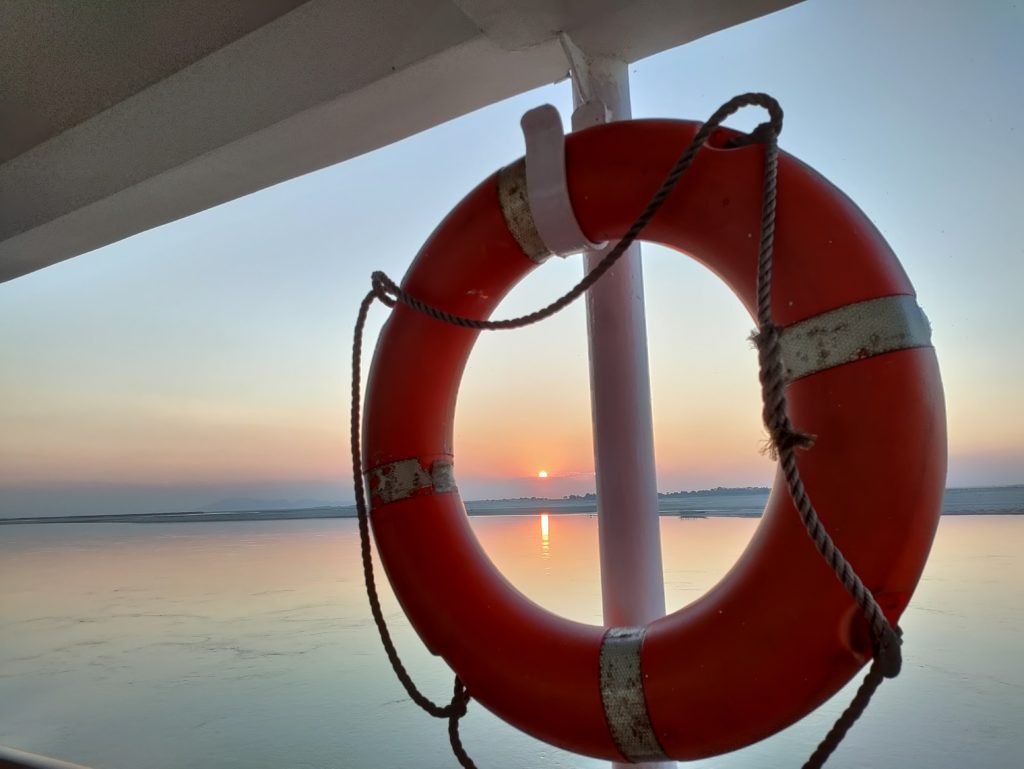
One of many beautiful sunsets on the Brahmaputra. * Photo: Hema Maira
Not Included in the Fares:
- Airfare
- Drinks on board
- Tips
Drinks prices:
- A bottle of wine was Rs.1800 (about $24 USD), 2000 (about $27 USD) or 2800 (about $38 USD) depending on the brand.
- (Wine is not sold by the glass, but smaller bottles of wine are also on sale depending on availability and cost about half the price of the larger bottles.)
- A glass of whiskey ranged from about $5 USD to $16 USD.
- For beer, Indian Kingfisher is Rs.180 (about $2.50 USD) for one pint.
Suggested tip amounts:
Sukpaha boat crew —
- Rs. 600 per person per day (for 5 days) = RS. 3000 total per person
Kaziranga guides & staff —
- Rs. 1200 per person (for staff at the lodge)
- Rs. 1000 per person (for safari drivers and guides)
- All tip amounts are divided equally among the number of people providing services
Ibex’s Brahmaputra River Cruise in Nov 2022:
Brahmaputra River cruises are offered from November to March, which is the best time of year.
Ibex is offering the 9-night “Crossing Borders” Brahmaputra River cruise package in November (2022), aboard ABN’s 36-passenger Charaidew II.
While there will be some similarities to the cruise I took, such as the visit to Kaziranga, the boat will be different on the November 2022 and the geographical location will be further upstream hence this cruise will have a similar vibe, but provide a distinctly different adventure.
Interested in this cruise? Please refer to the Ibex Expeditions website for more details and booking info.
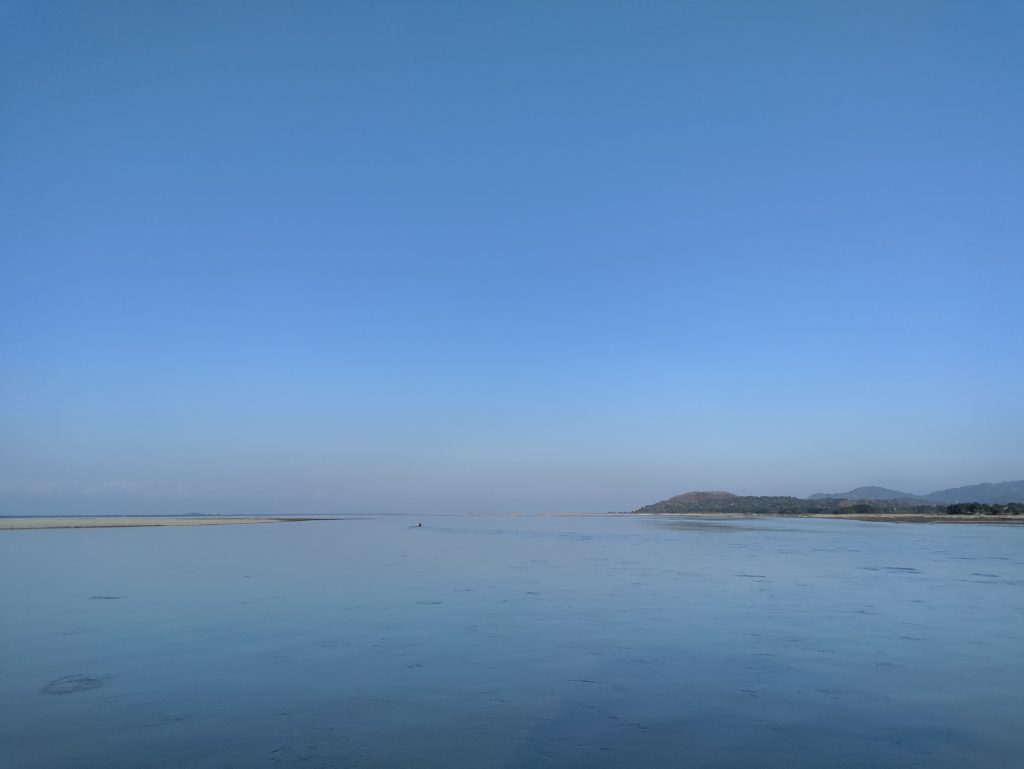
Meeting point of Brahmaputra River and the sky. * Photo: Hema Maira
RELATED: Heidi reviews her Brahmaputra River cruise aboard the 46-pax Mahabaahu.
Don’t miss a post about small-ship cruising, subscribe to QuirkyCruise.com for monthly updates & special offers!
© This article is protected by copyright, no part may be reproduced by any process without written permission from the author. All Rights Reserved. QuirkyCruise.com.

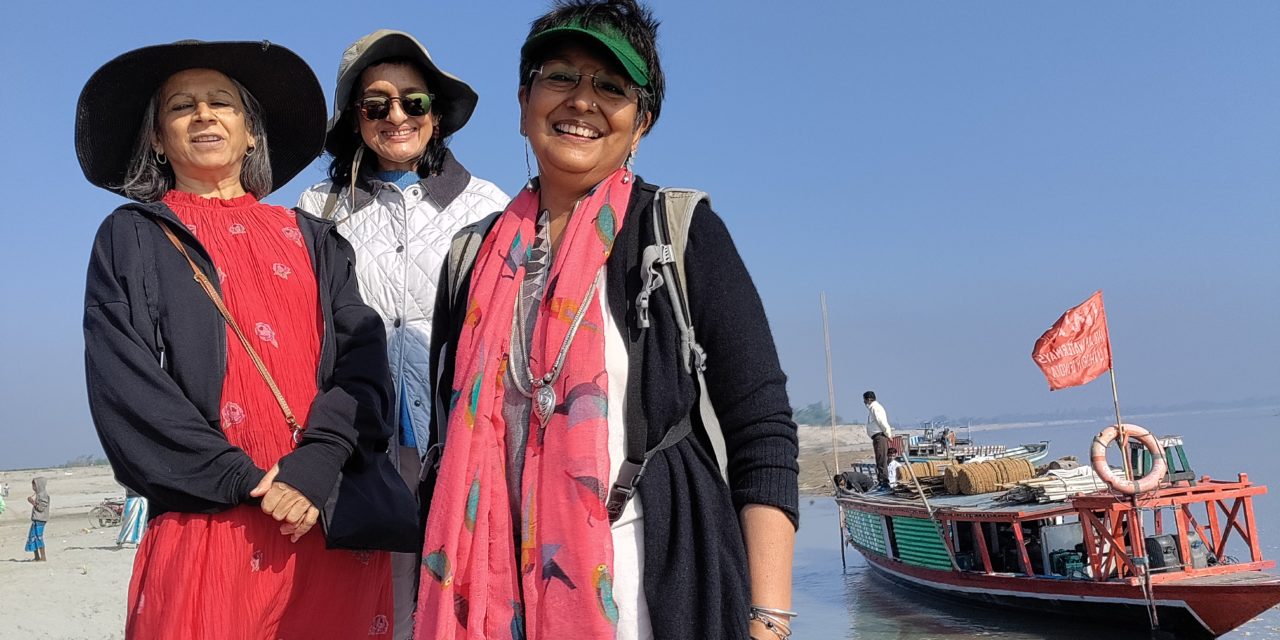

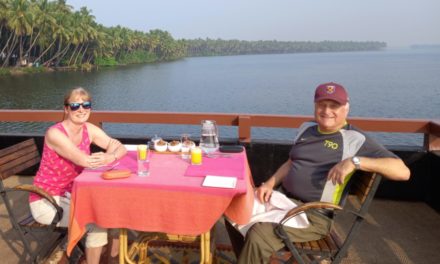
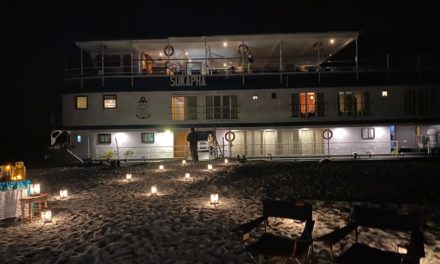
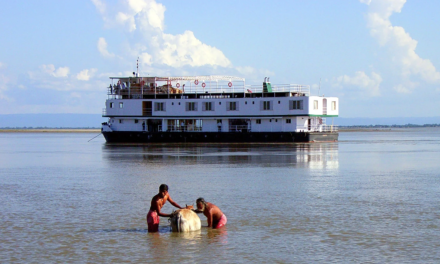








 HEIDI SARNA
HEIDI SARNA





